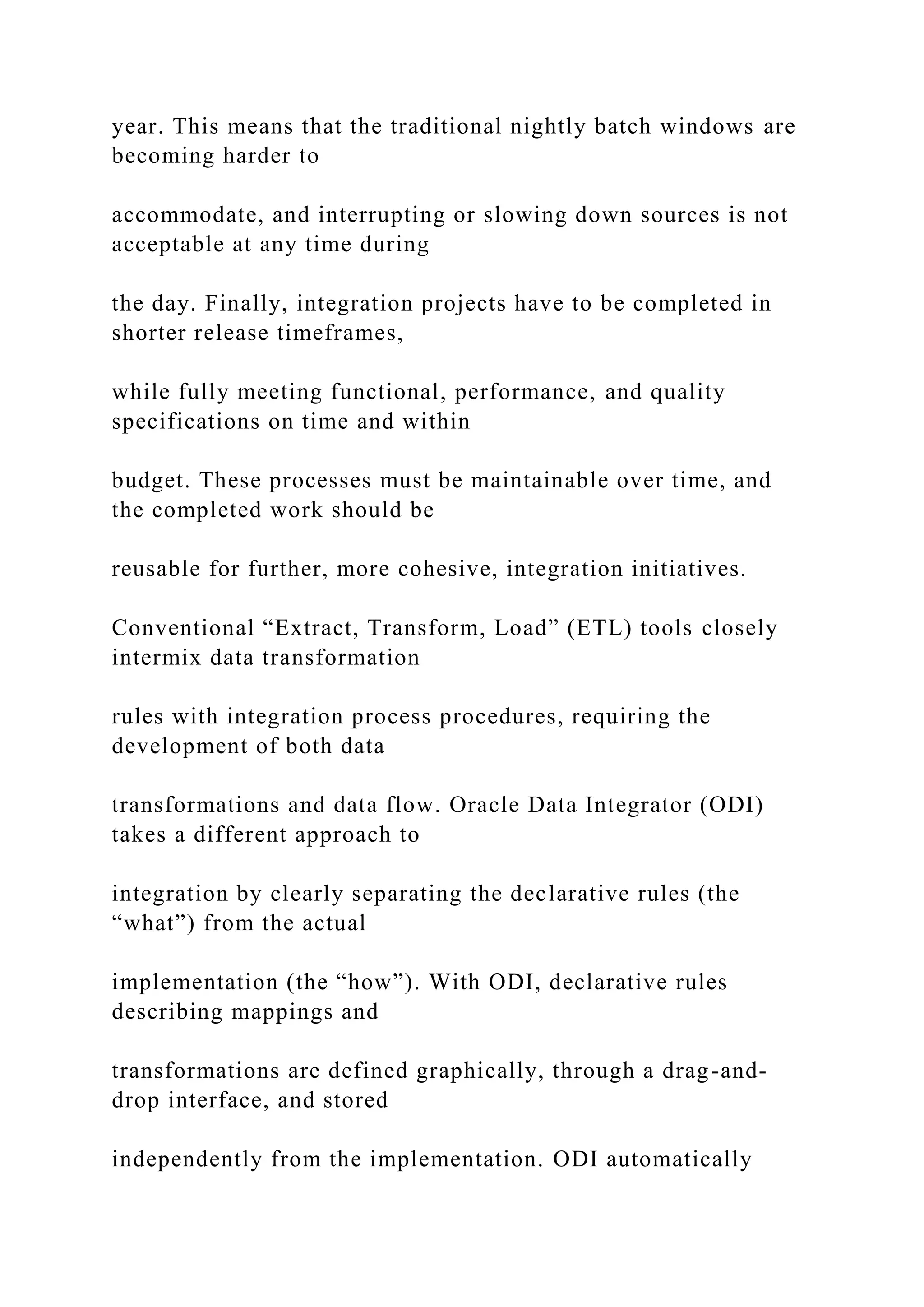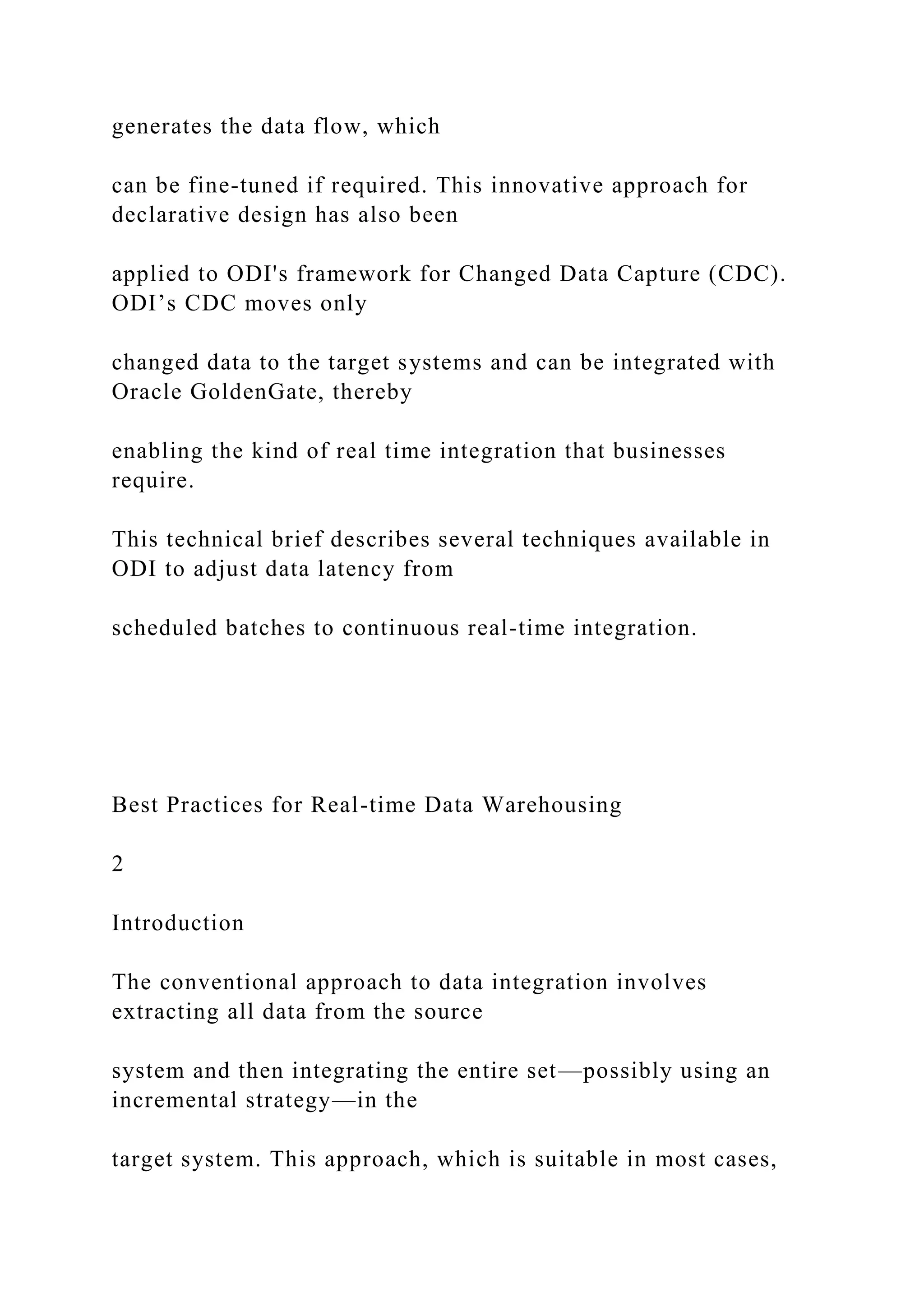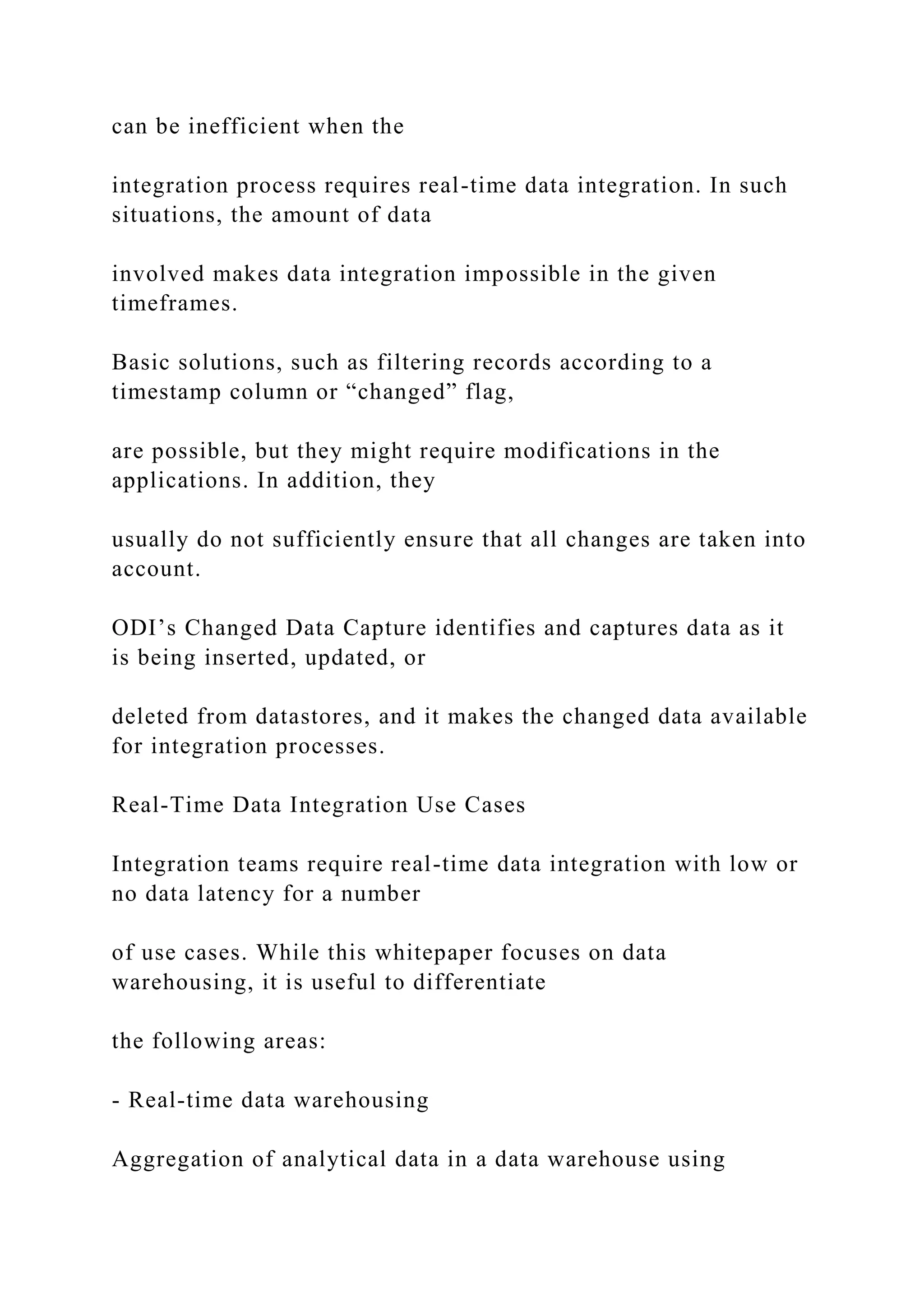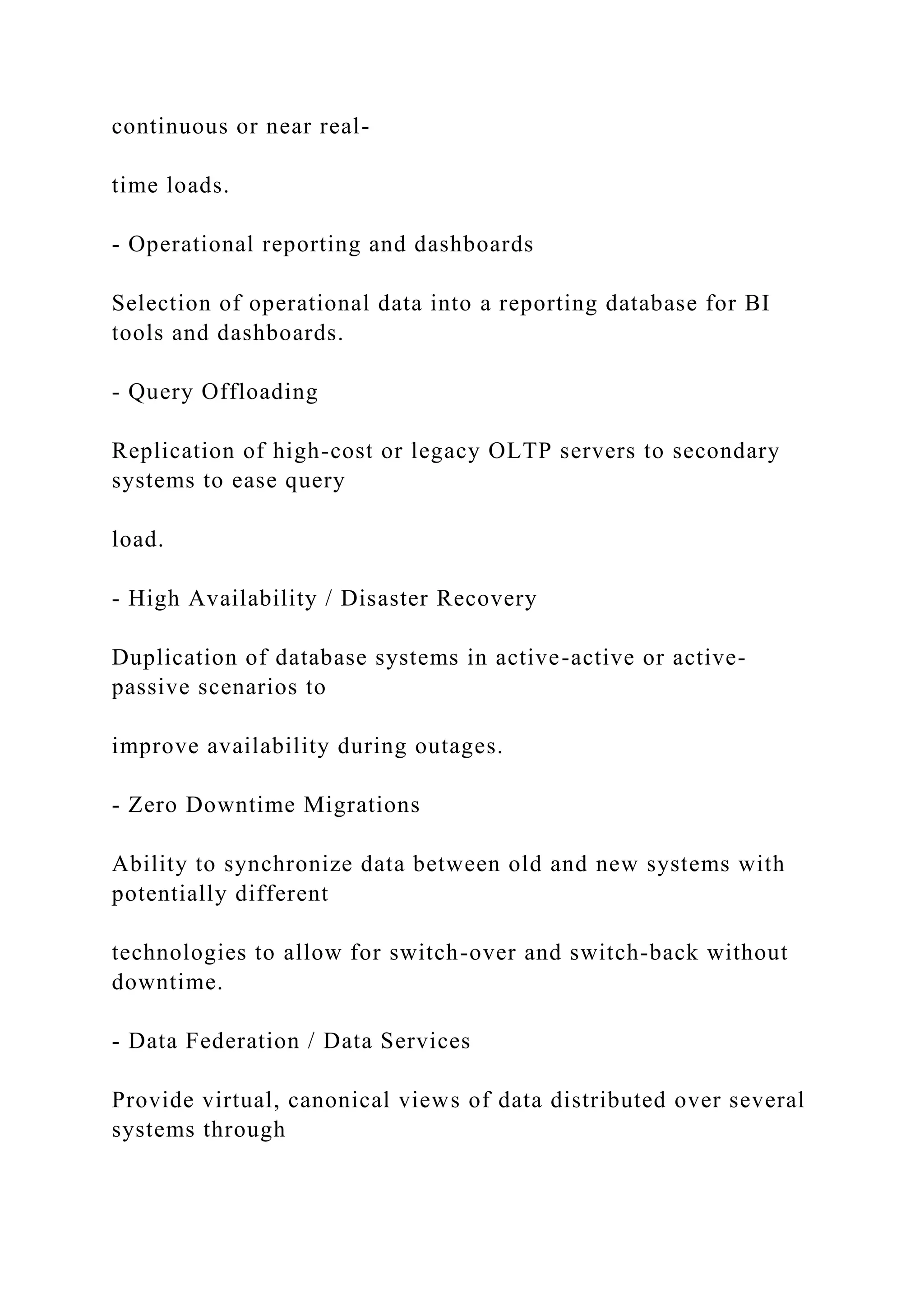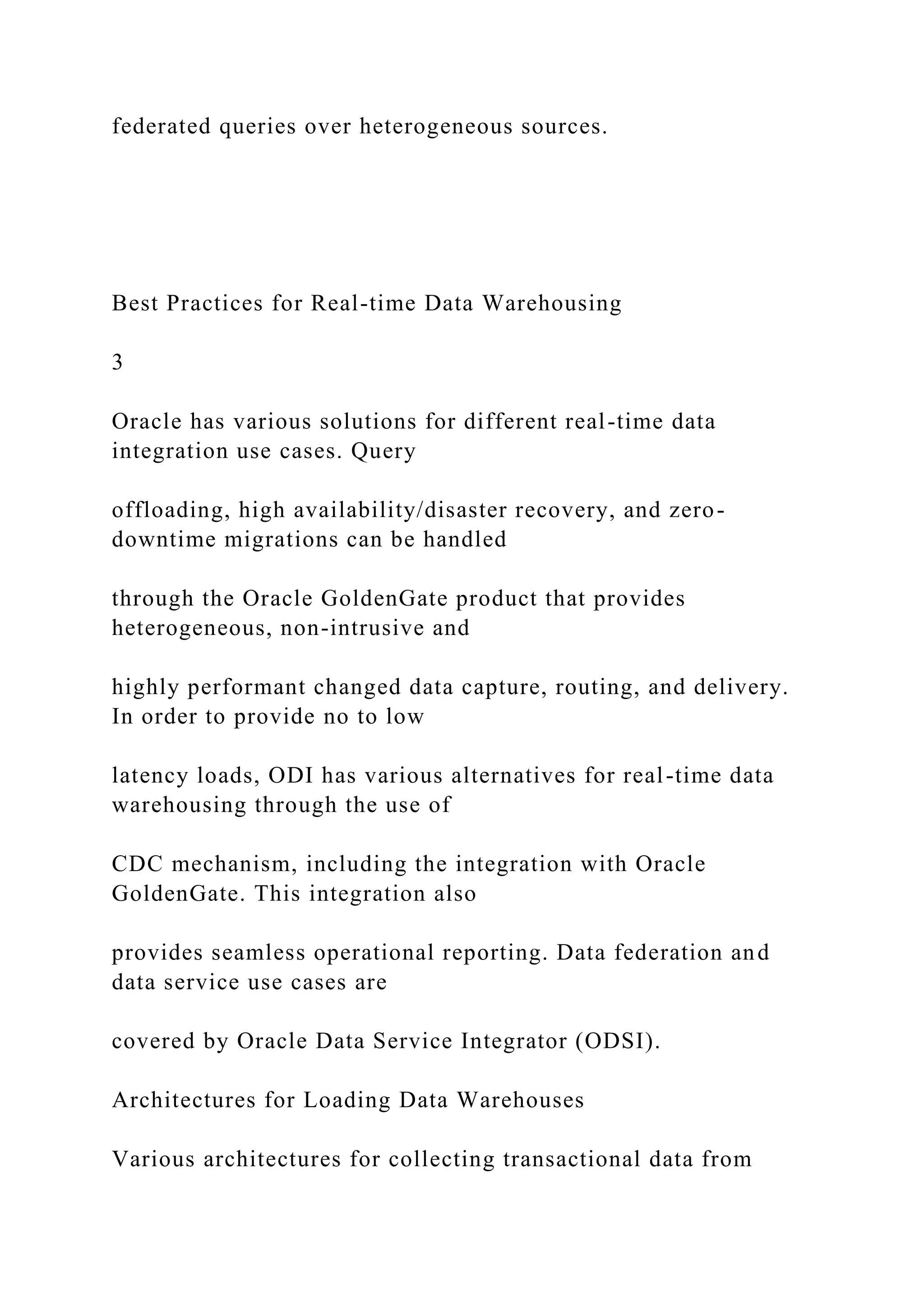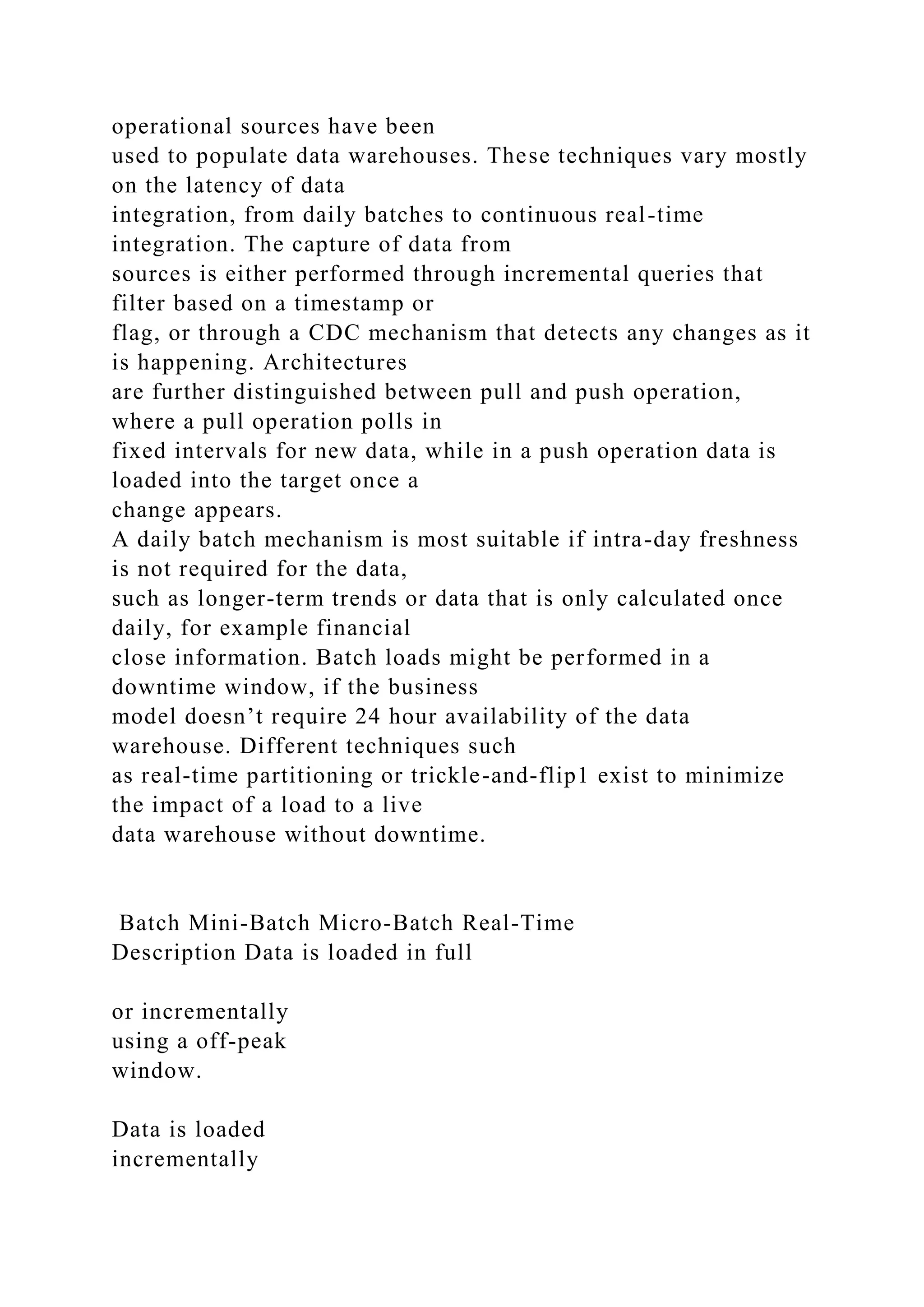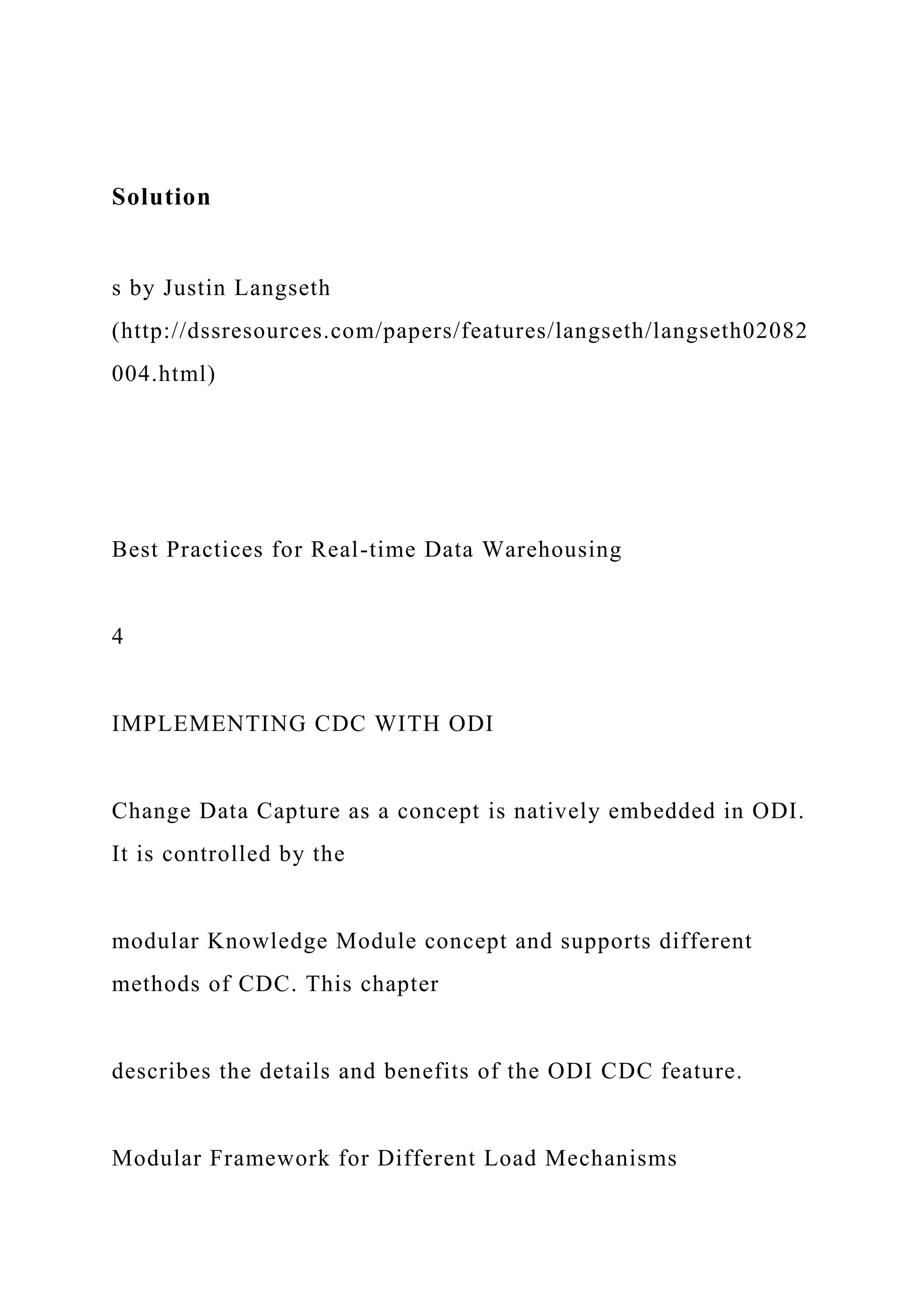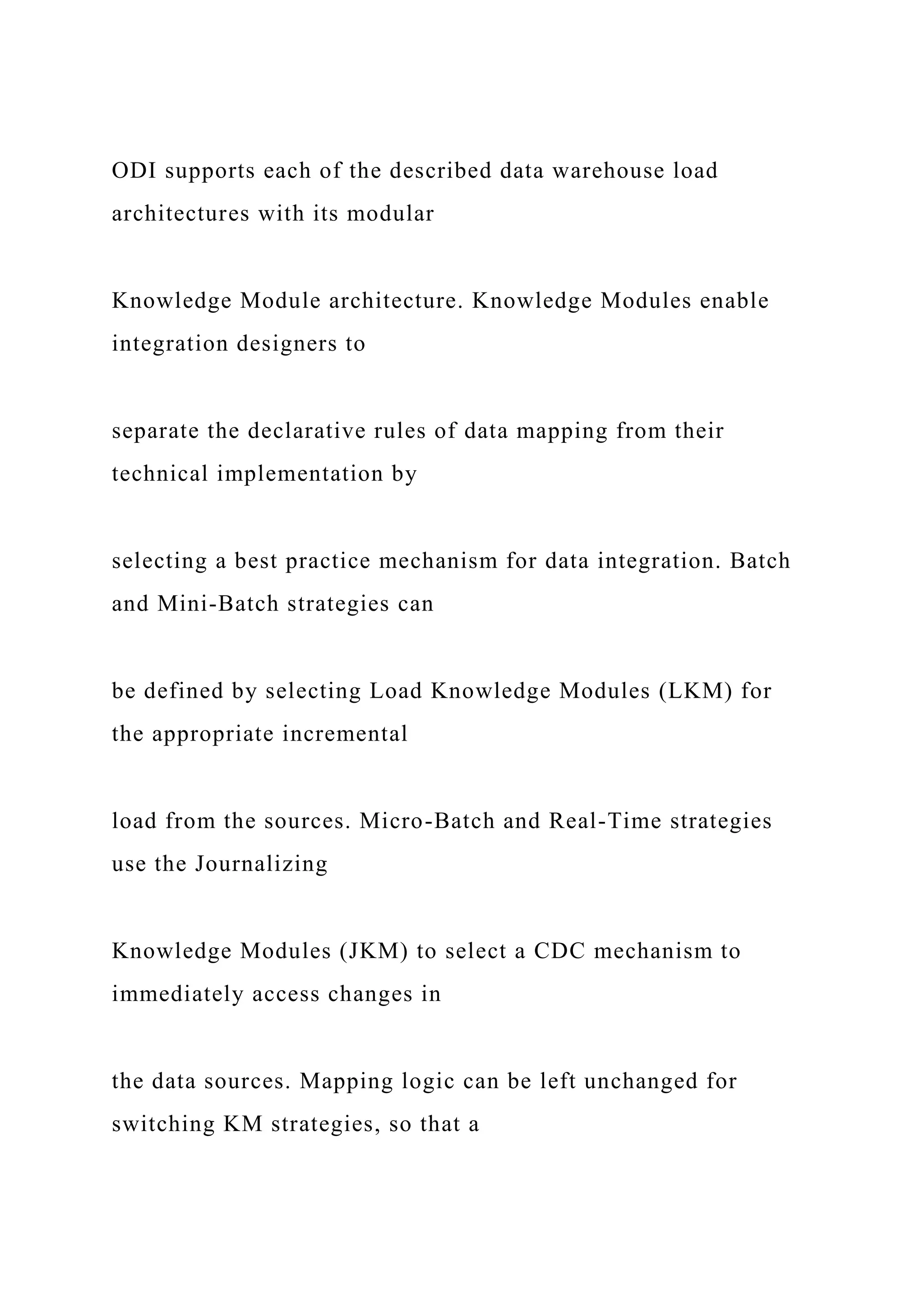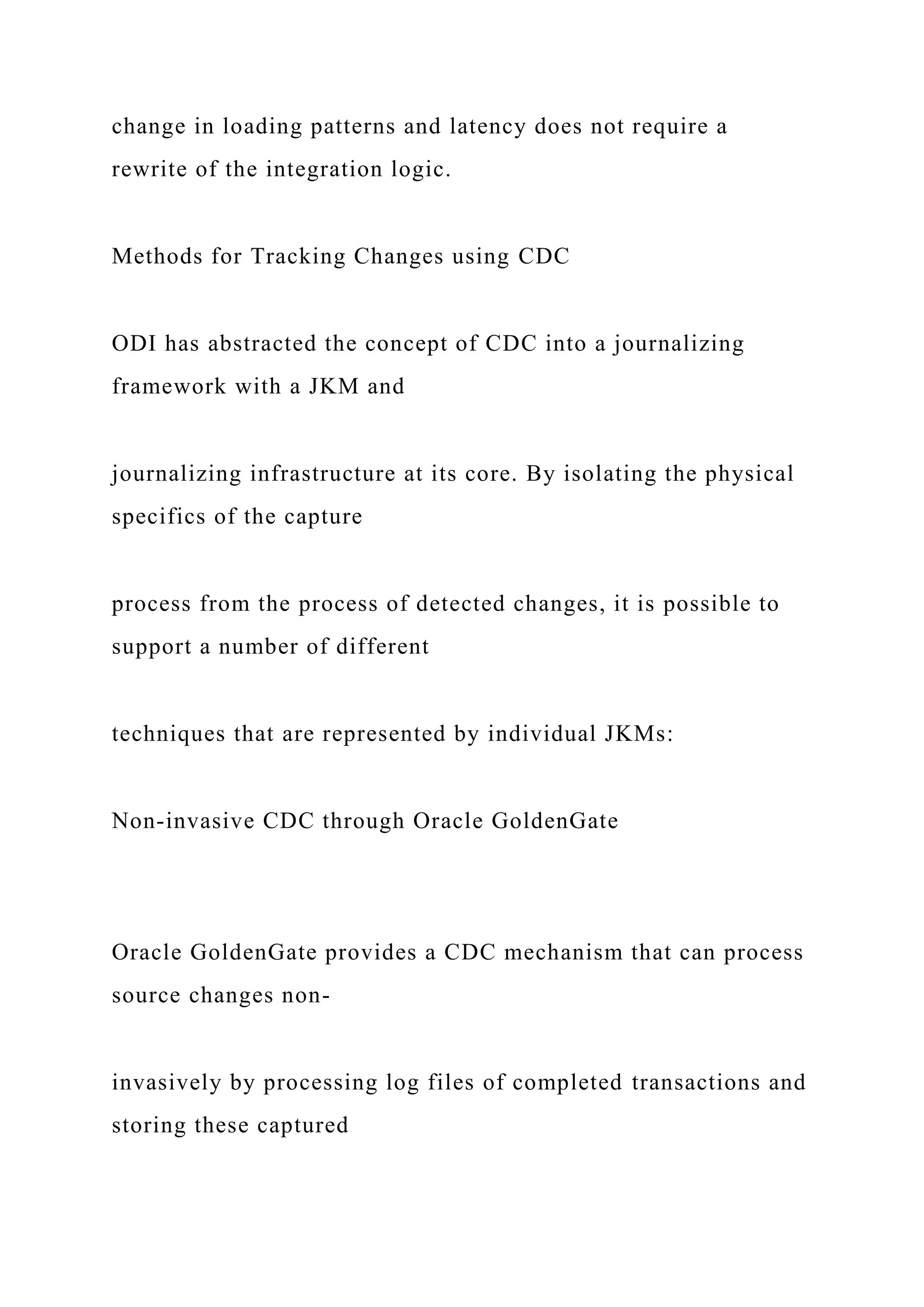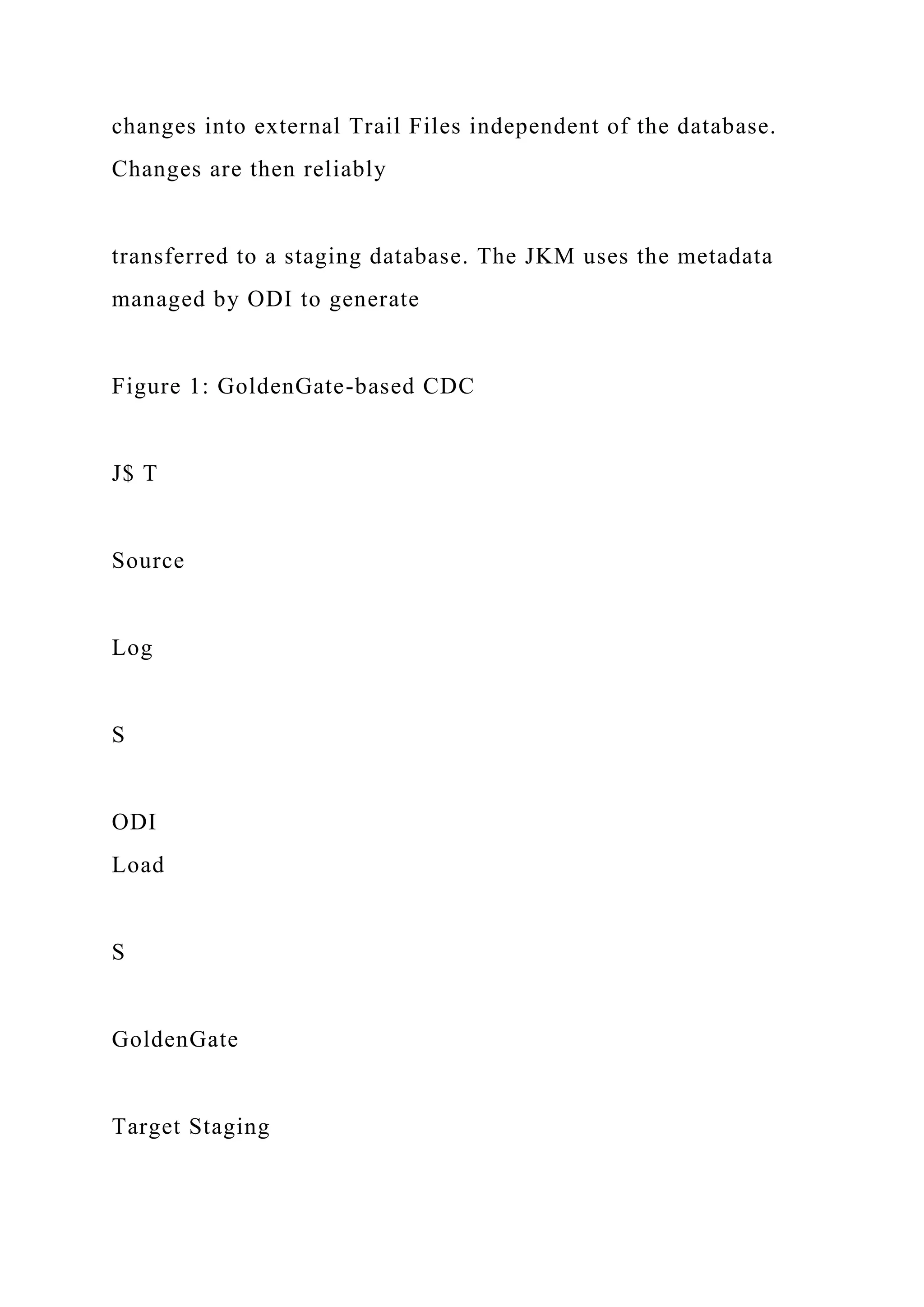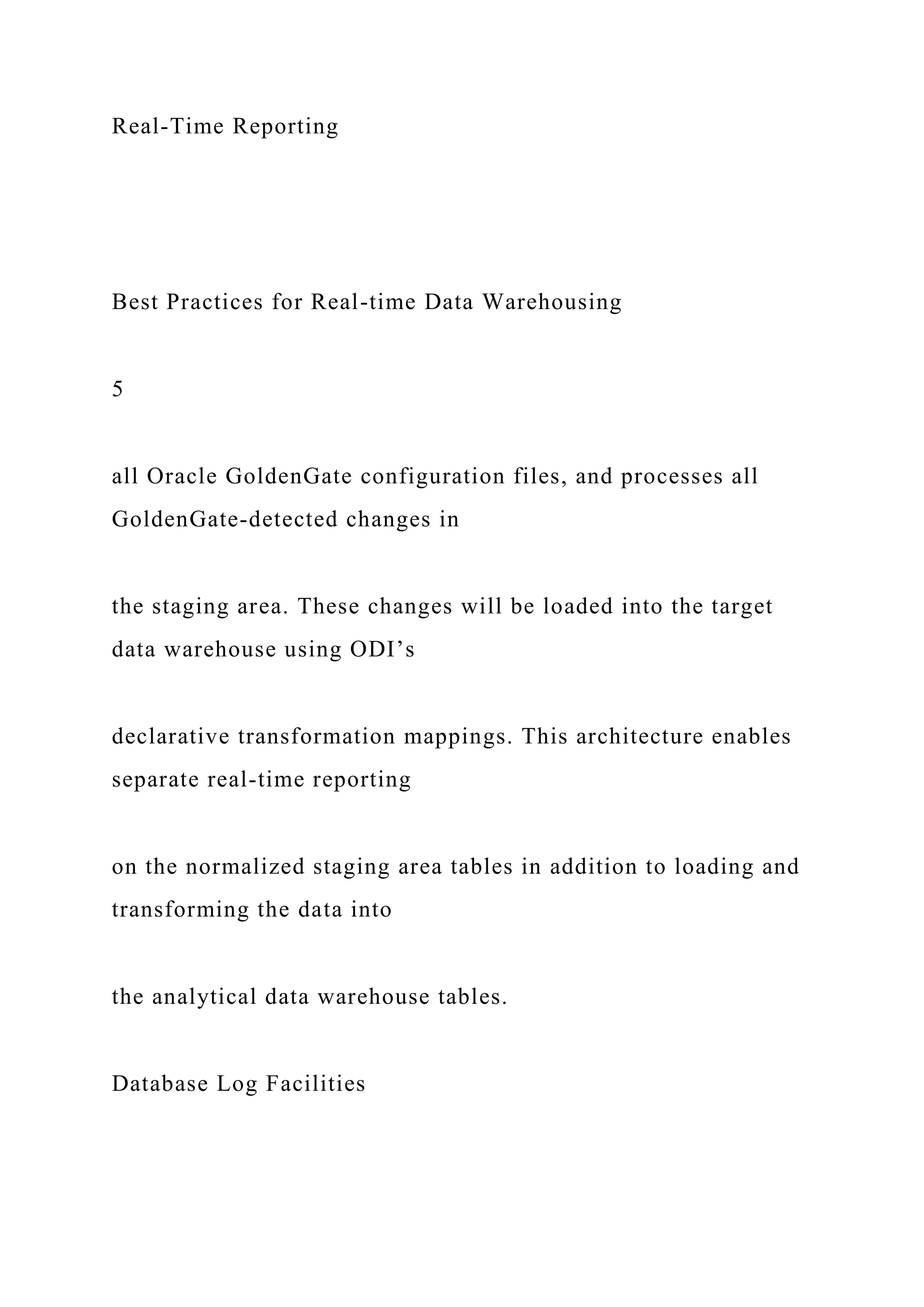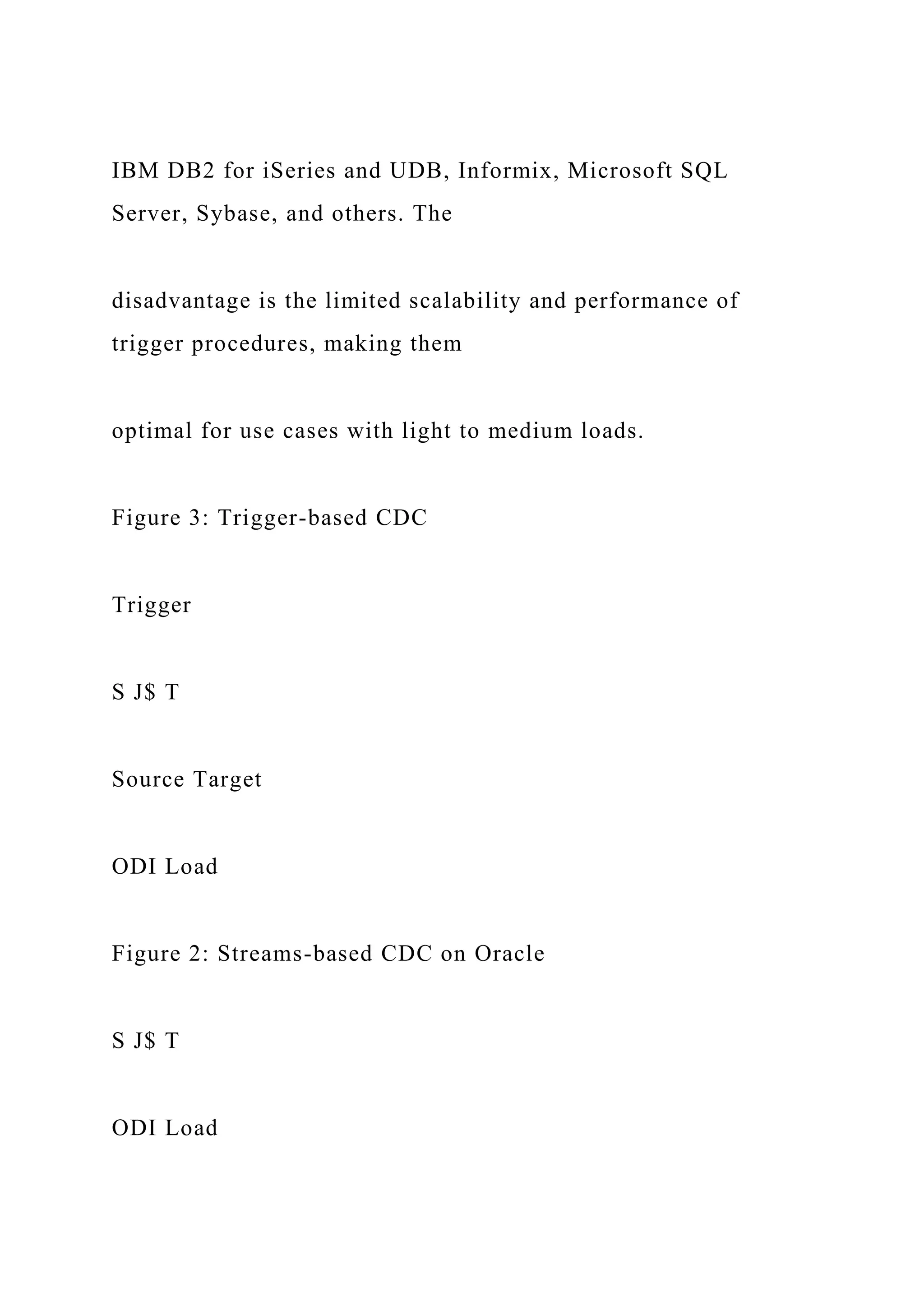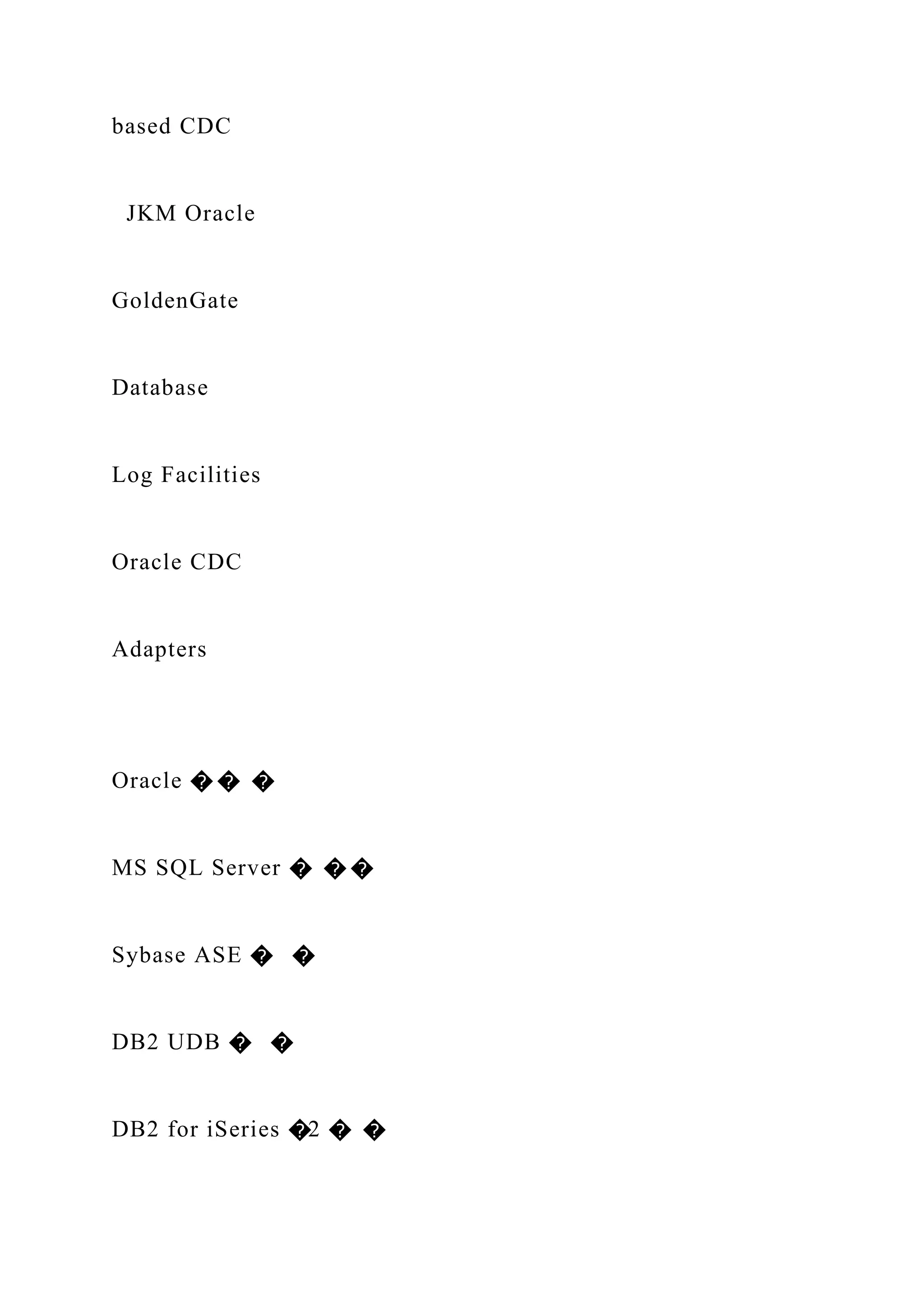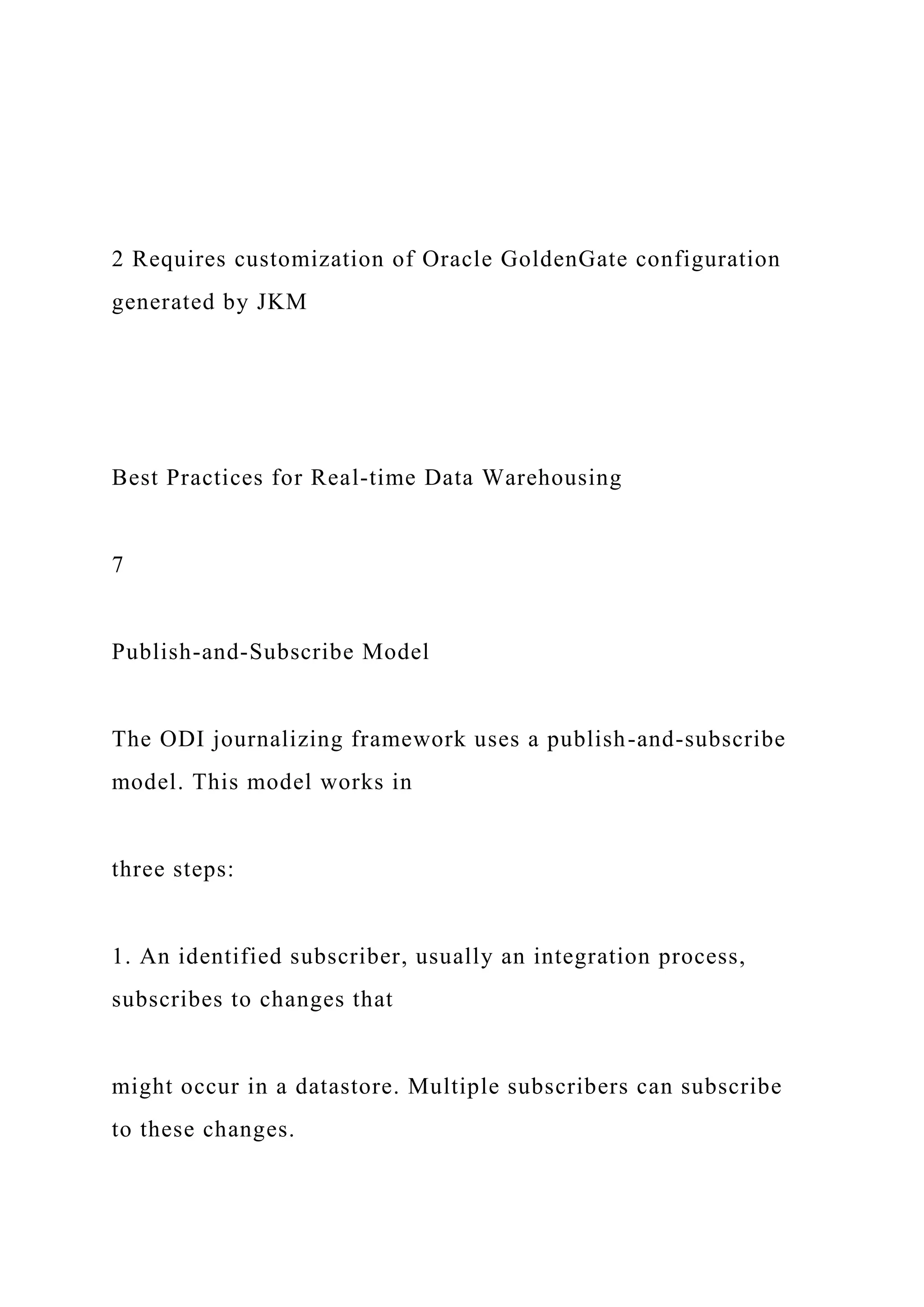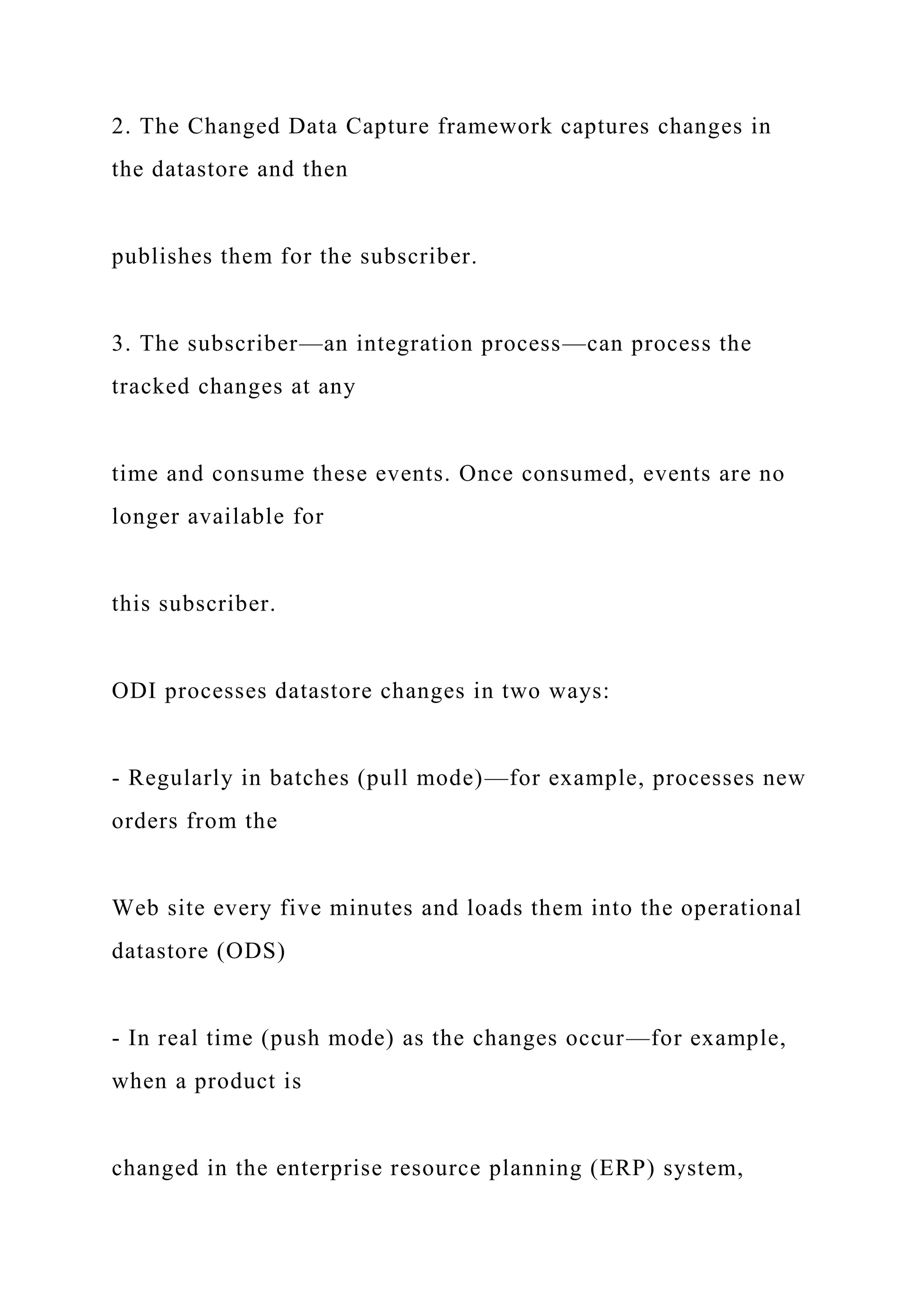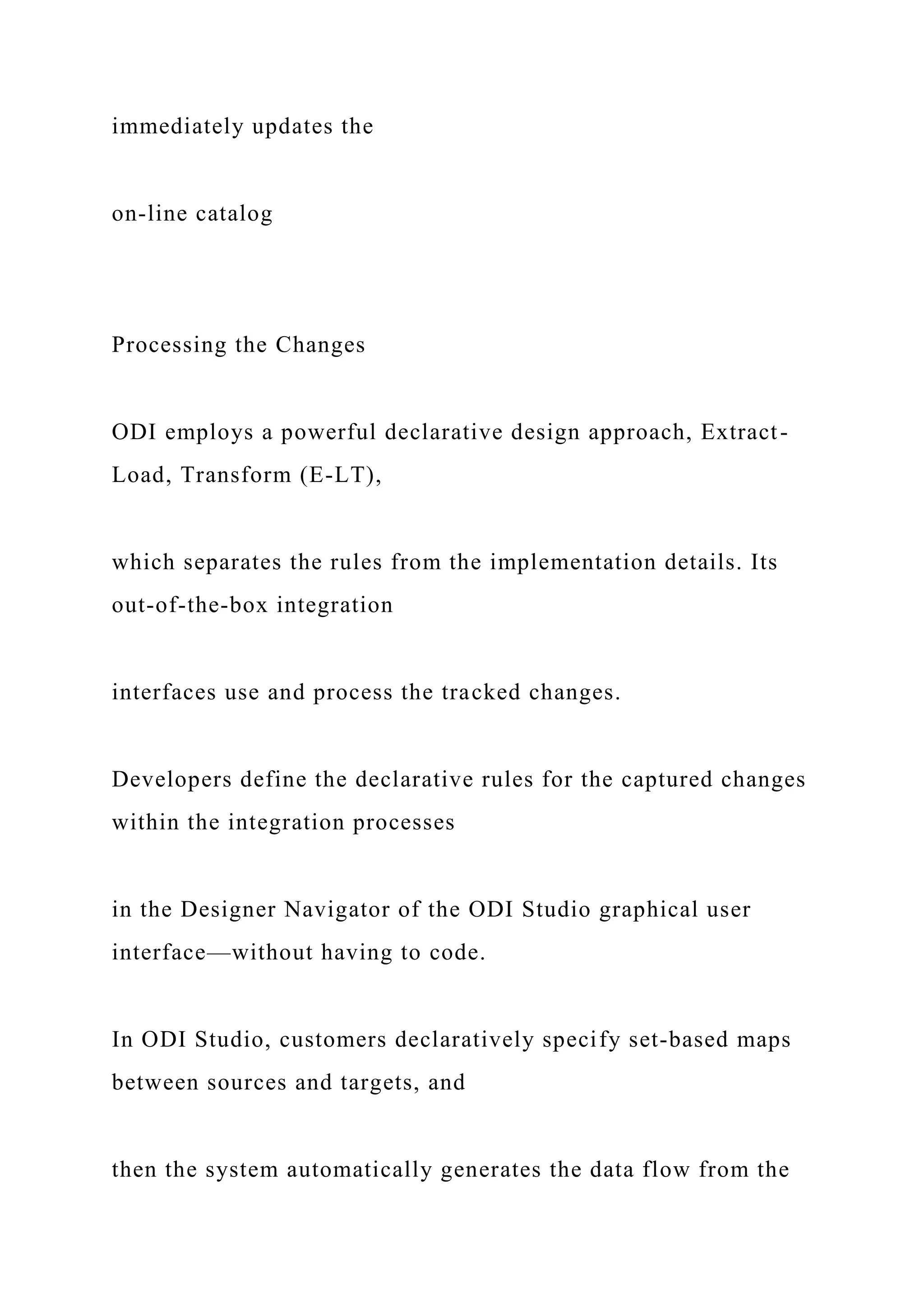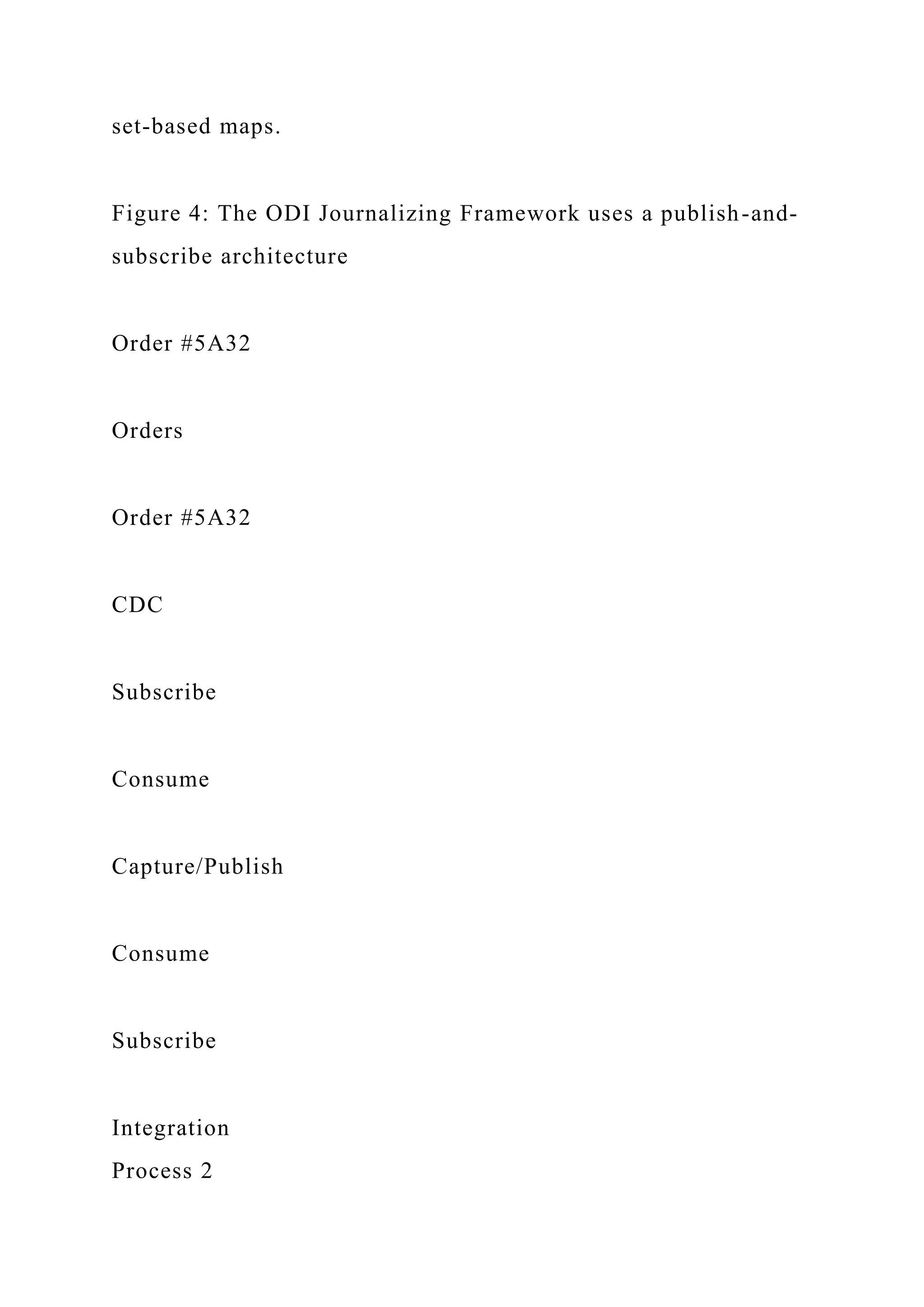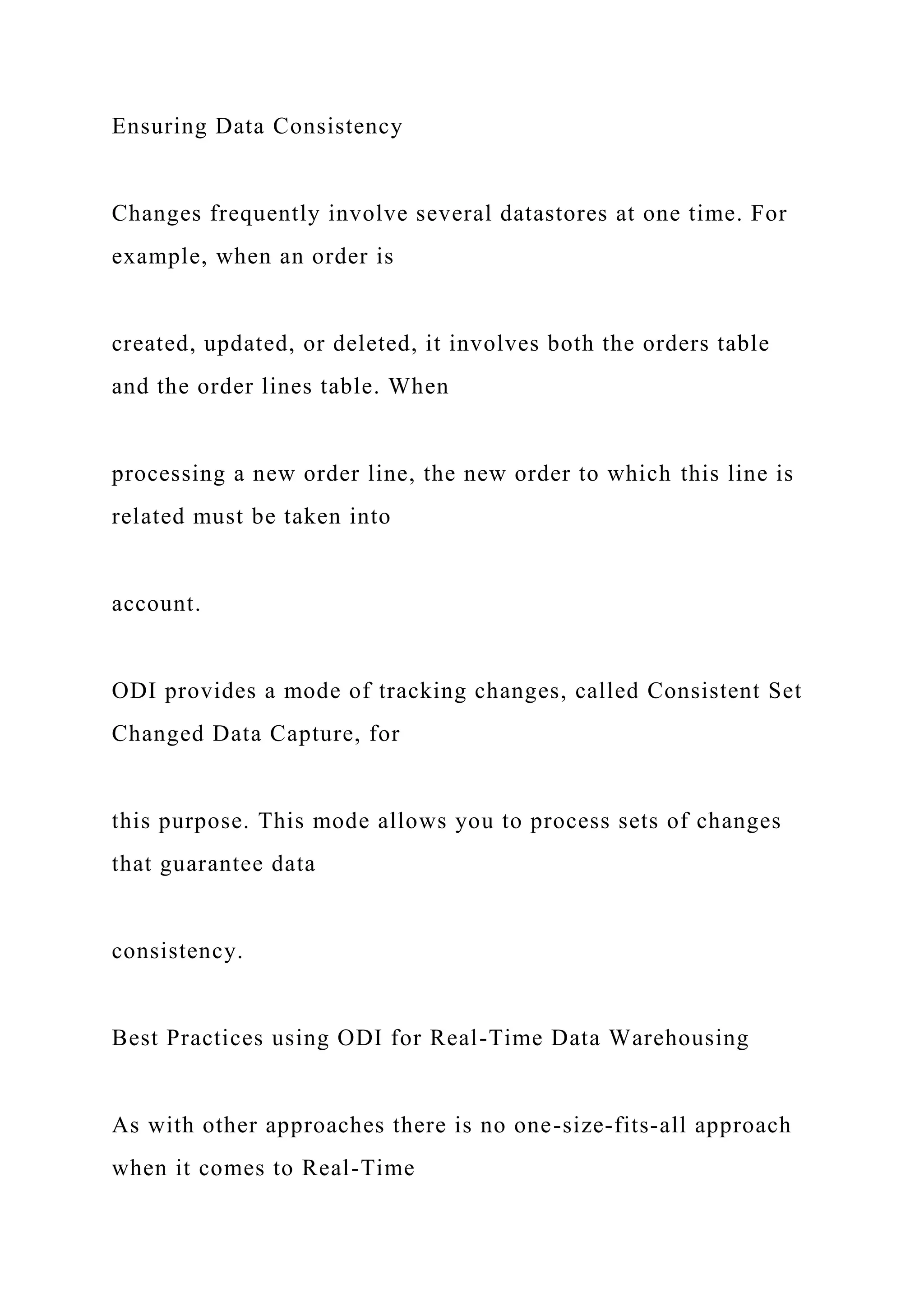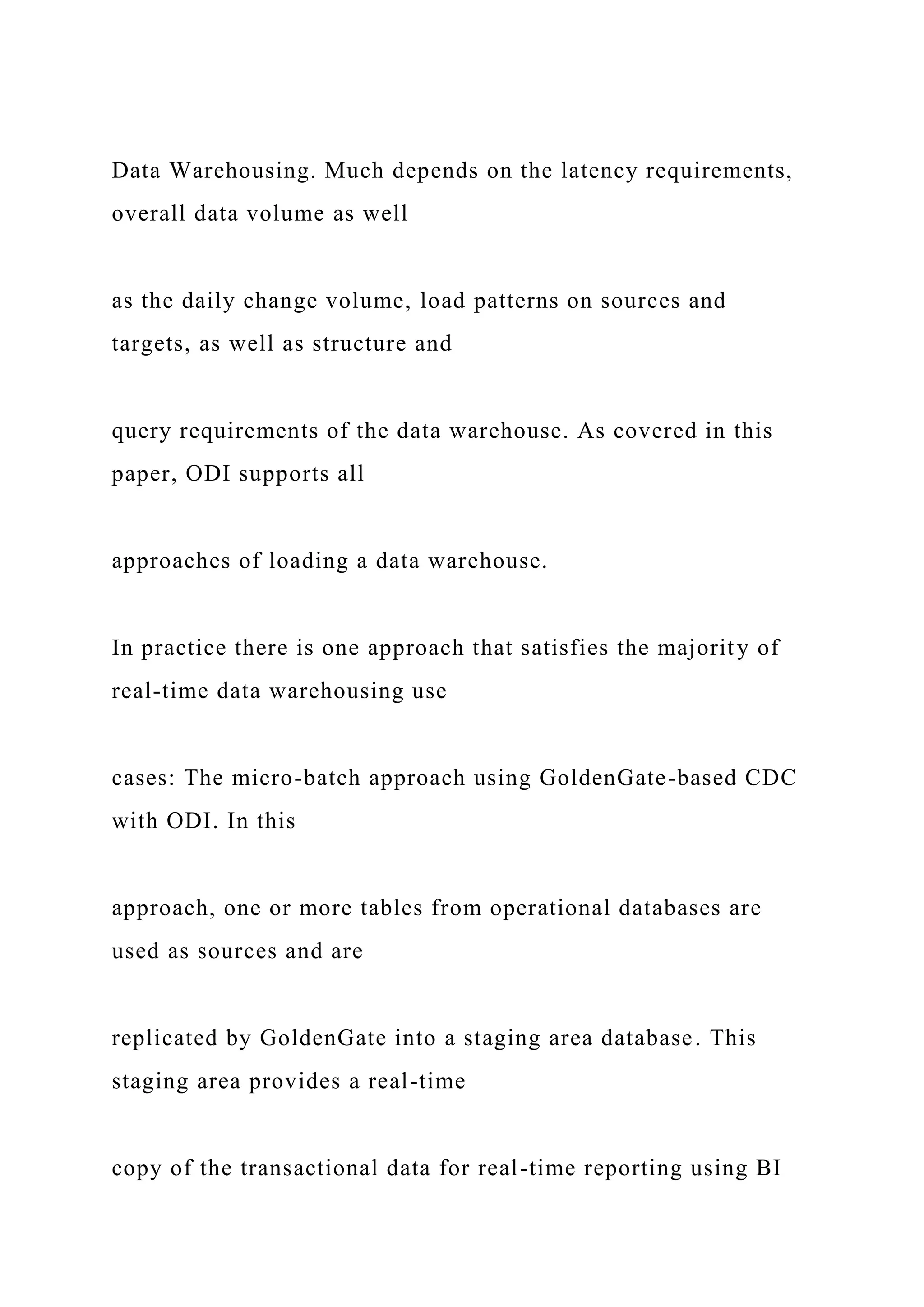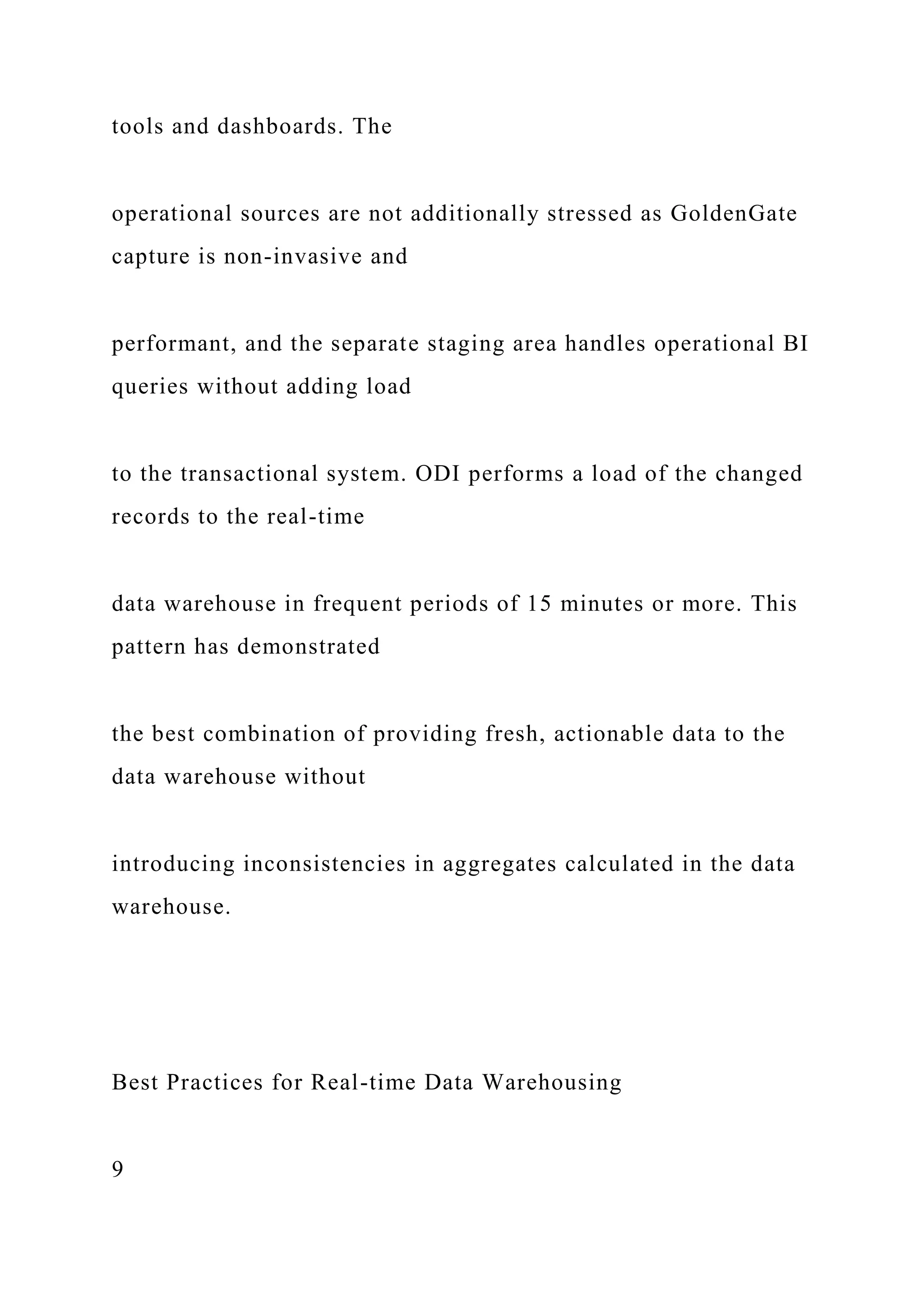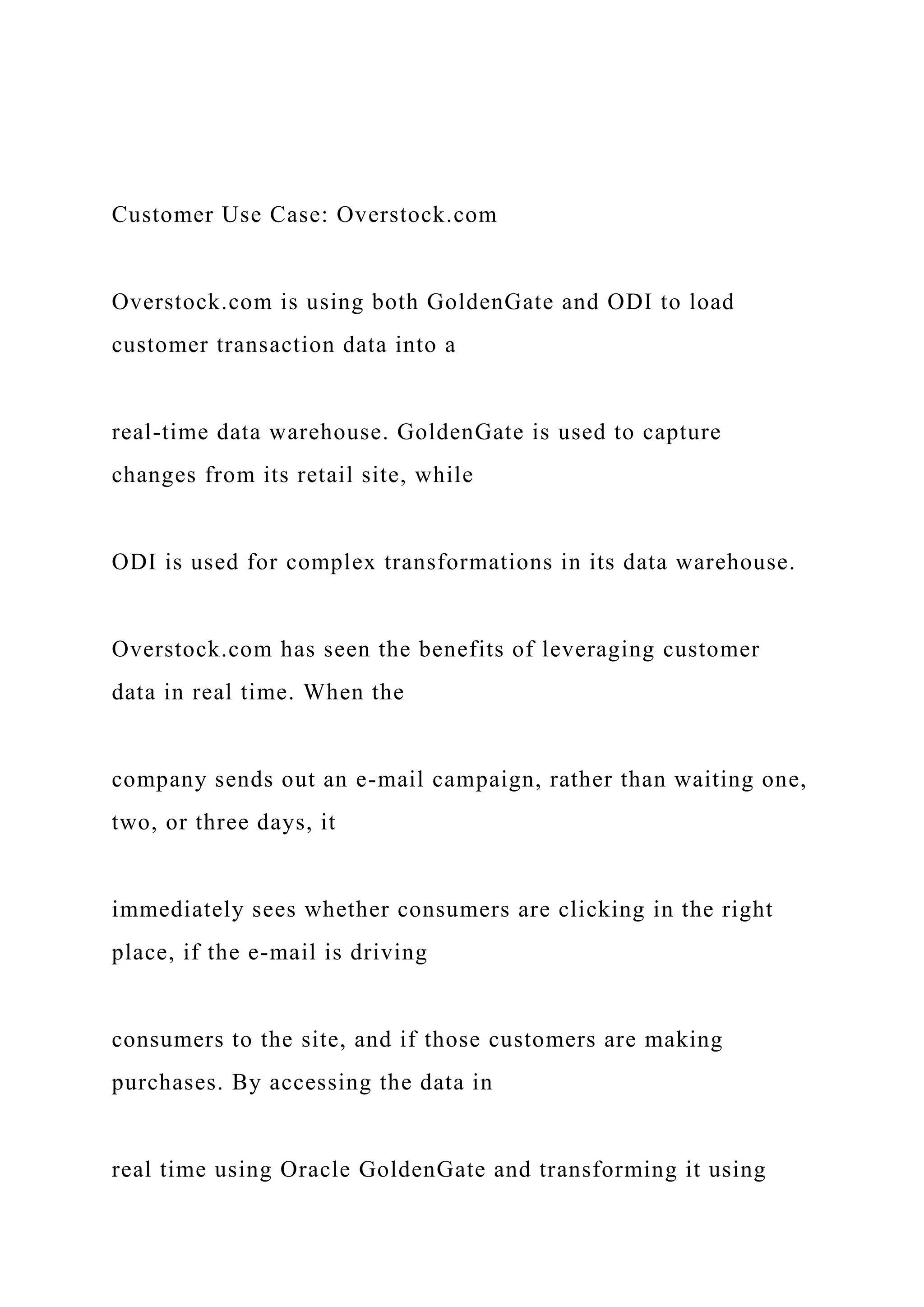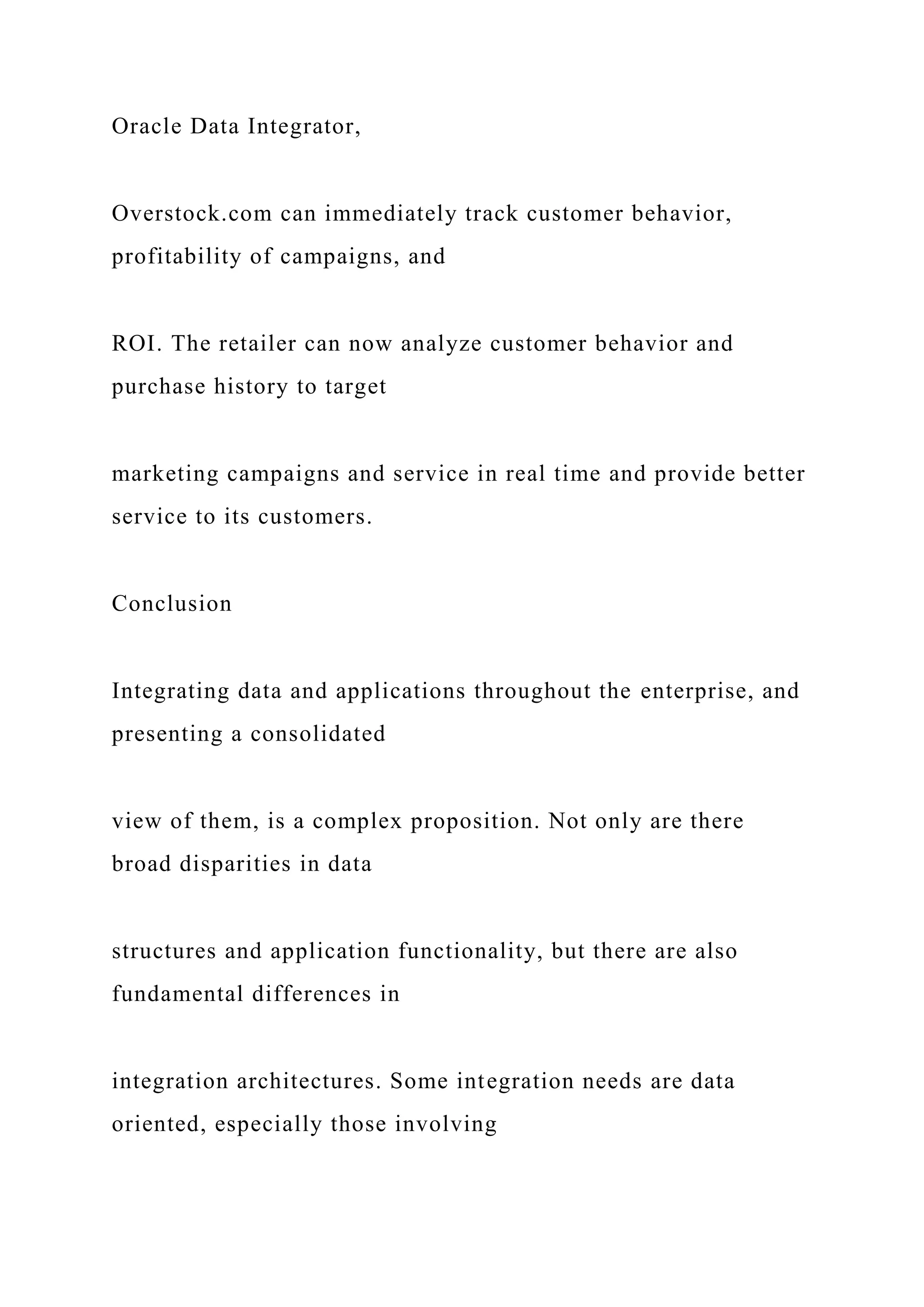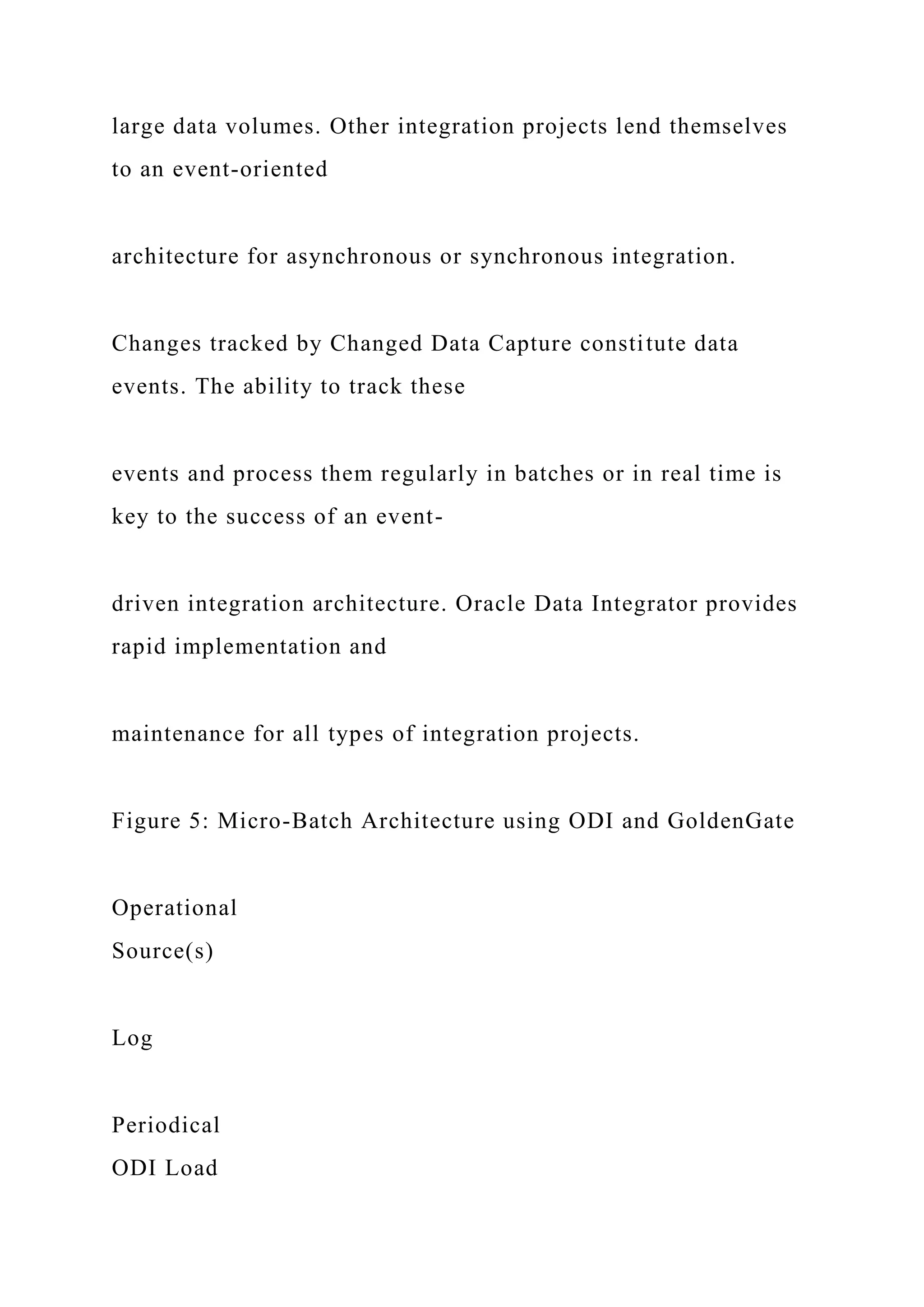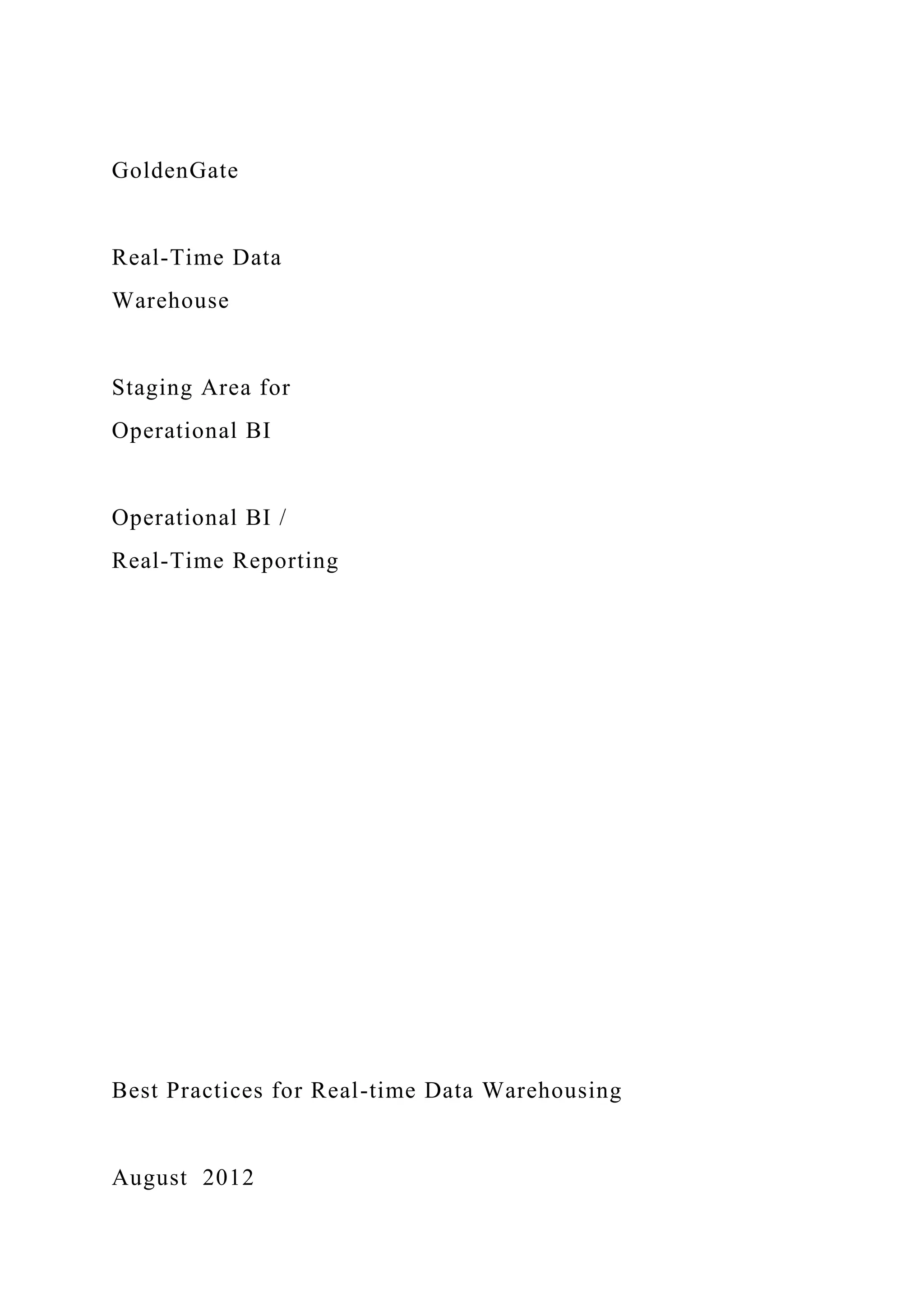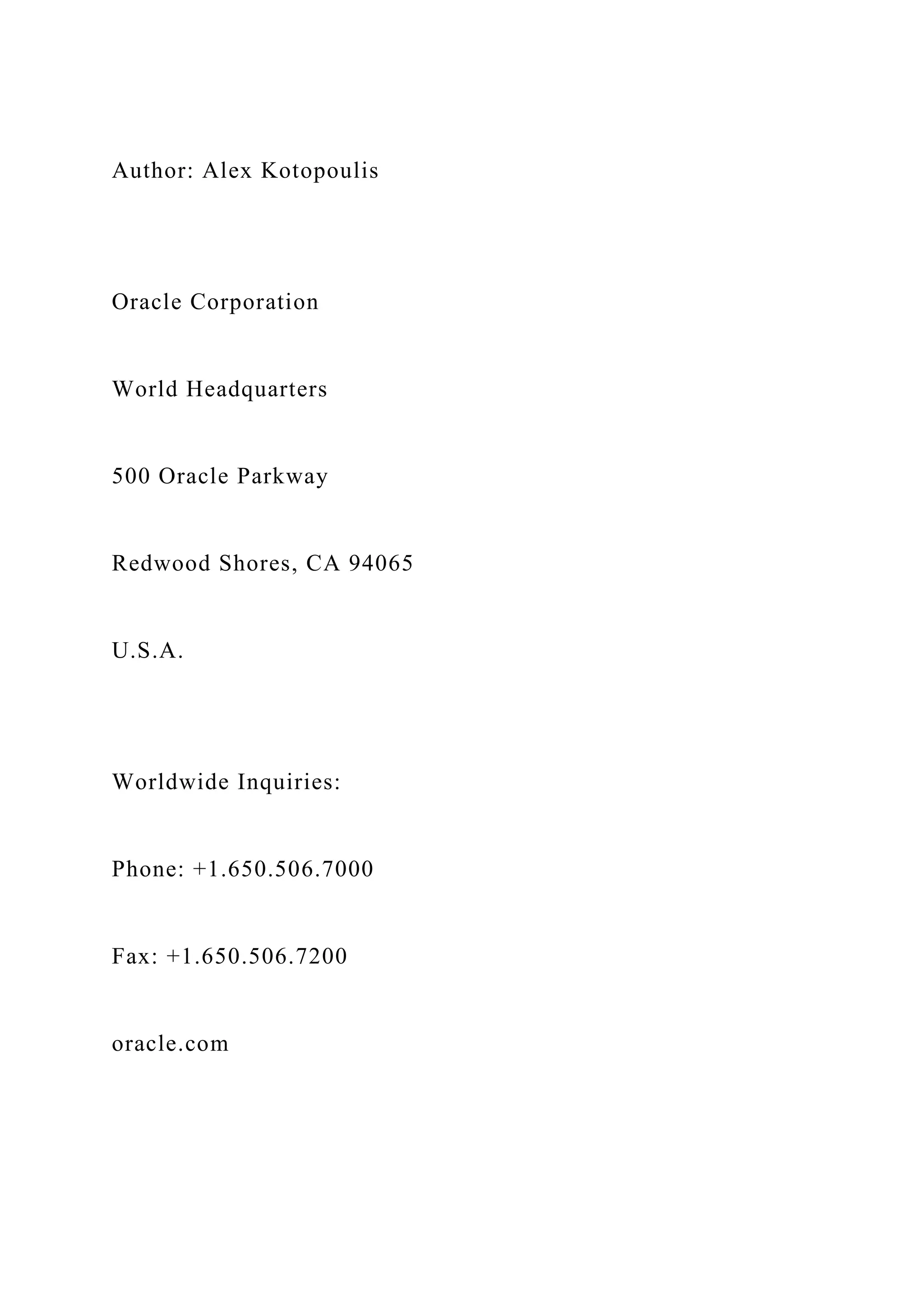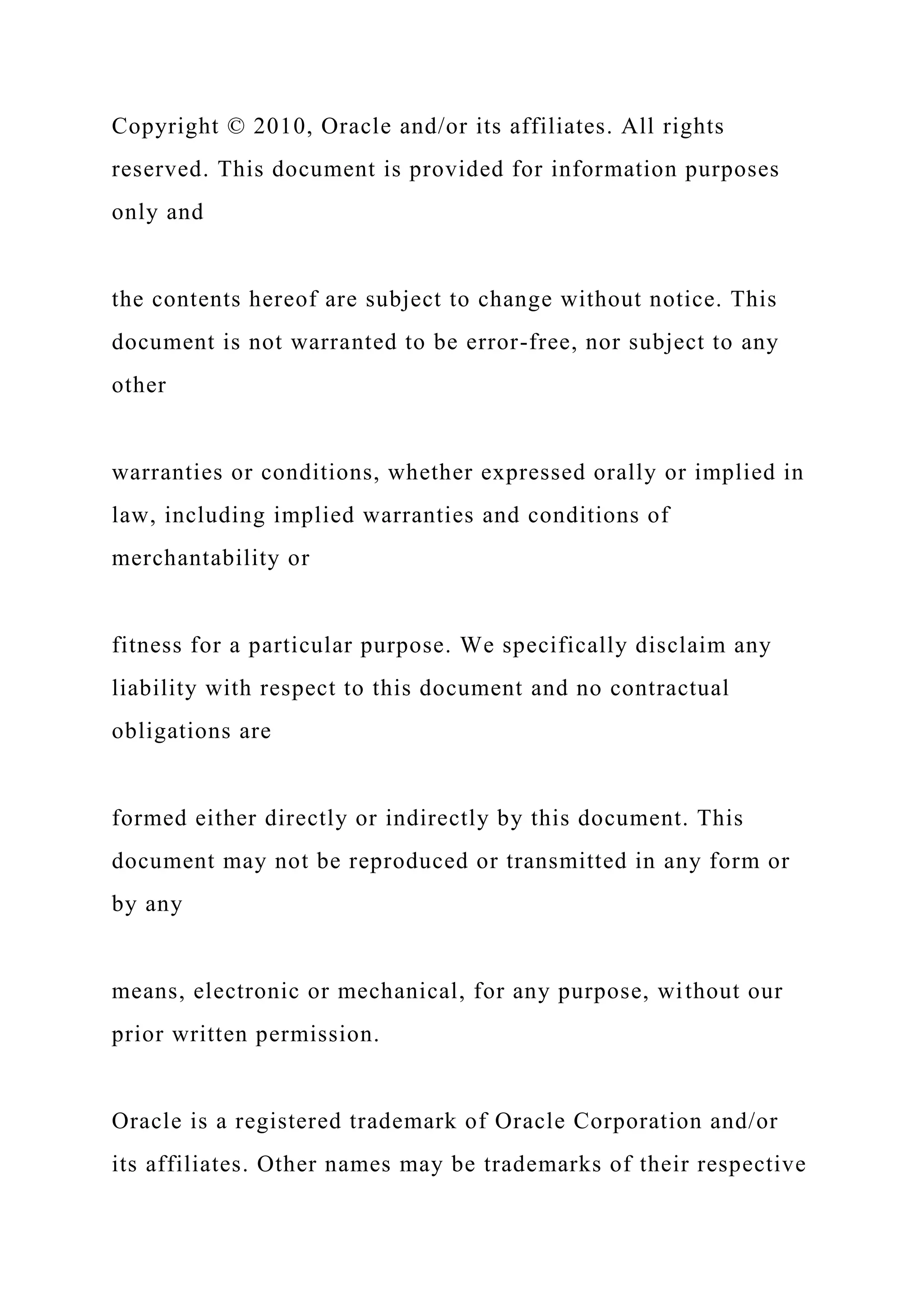This paper presents a methodology for adapting data warehouse schemas and OLAP queries to support real-time data integration, addressing the limitations of traditional data warehouses which update data periodically. The proposed system allows for continuous integration of operational data into the data warehouse while minimizing performance impacts on OLAP queries. The methodology emphasizes the importance of maintaining data freshness and reducing update time windows to enhance user access to current information for decision-making processes.
![Real-Time Data Warehouse Loading Methodology
Ricardo Jorge Santos
CISUC – Centre of Informatics and Systems
DEI – FCT – University of Coimbra
Coimbra, Portugal
[email protected]
Jorge Bernardino
CISUC, IPC – Polytechnic Institute of Coimbra
ISEC – Superior Institute of Engineering of Coimbra
Coimbra, Portugal
[email protected]
ABSTRACT
A data warehouse provides information for analytical
processing,
decision making and data mining tools. As the concept of real-
time enterprise evolves, the synchronism between transactional
data and data warehouses, statically implemented, has been
redefined. Traditional data warehouse systems have static
structures of their schemas and relationships between data, and
therefore are not able to support any dynamics in their structure
and content. Their data is only periodically updated because
they
are not prepared for continuous data integration. For real-time
enterprises with needs in decision support purposes, real-time
data
warehouses seem to be very promising. In this paper we present
a](https://image.slidesharecdn.com/real-timedatawarehouseloadingmethodologyricardojorges-221031045647-57ea5f98/75/Real-Time-Data-Warehouse-Loading-Methodology-Ricardo-Jorge-S-docx-1-2048.jpg)
![methodology on how to adapt data warehouse schemas and user-
end OLAP queries for efficiently supporting real-time data
integration. To accomplish this, we use techniques such as table
structure replication and query predicate restrictions for
selecting
data, to enable continuously loading data in the data warehouse
with minimum impact in query execution time. We demonstrate
the efficiency of the method by analyzing its impact in query
performance using benchmark TPC-H executing query
workloads
while simultaneously performing continuous data integration at
various insertion time rates.
Keywords
real-time and active data warehousing, continuous data
integration for data warehousing, data warehouse refreshment
loading process.
1. INTRODUCTION
A data warehouse (DW) provides information for analytical
processing, decision making and data mining tools. A DW
collects data from multiple heterogeneous operational source
systems (OLTP – On-Line Transaction Processing) and stores
summarized integrated business data in a central repository used
by analytical applications (OLAP – On-Line Analytical
Processing) with different user requirements. The data area of a
data warehouse usually stores the complete history of a
business.
The common process for obtaining decision making information
is based on using OLAP tools [7]. These tools have their data
source based on the DW data area, in which records are updated
by ETL (Extraction, Transformation and Loading) tools. The
ETL
processes are responsible for identifying and extracting the
relevant data from the OLTP source systems, customizing and](https://image.slidesharecdn.com/real-timedatawarehouseloadingmethodologyricardojorges-221031045647-57ea5f98/75/Real-Time-Data-Warehouse-Loading-Methodology-Ricardo-Jorge-S-docx-2-2048.jpg)
![integrating this data into a common format, cleaning the data
and
conforming it into an adequate integrated format for updating
the
data area of the DW and, finally, loading the final formatted
data
into its database.
Traditionally, it has been well accepted that data warehouse
databases are updated periodically – typically in a daily, weekly
or even monthly basis [28] – implying that its data is never up-
to-
date, for OLTP records saved between those updates are not
included the data area. This implies that the most recent
operational records are not included into the data area, thus
getting excluded from the results supplied by OLAP tools. Until
recently, using periodically updated data was not a crucial
issue.
However, with enterprises such as e-business, stock brokering,
online telecommunications, and health systems, for instance,
relevant information needs to be delivered as fast as possible to
knowledge workers or decision systems who rely on it to react
in
a near real-time manner, according to the new and most recent
data captured by an organization’s information system [8]. This
makes supporting near real-time data warehousing (RTDW) a
critical issue for such applications.
The demand for fresh data in data warehouses has always been a
strong desideratum. Data warehouse refreshment (integration of
new data) is traditionally performed in an off-line fashion. This
means that while processes for updating the data area are
executed, OLAP users and applications cannot access any data.
This set of activities usually takes place in a preset loading time
window, to avoid overloading the operational OLTP source
systems with the extra workload of this workflow. Still, users](https://image.slidesharecdn.com/real-timedatawarehouseloadingmethodologyricardojorges-221031045647-57ea5f98/75/Real-Time-Data-Warehouse-Loading-Methodology-Ricardo-Jorge-S-docx-3-2048.jpg)
![are
pushing for higher levels of freshness, since more and more
enterprises operate in a business time schedule of 24x7. Active
Data Warehousing refers to a new trend where DWs are updated
as frequently as possible, due to the high demands of users for
fresh data. The term is also designated as Real-Time Data
Warehousing for that reason in [24]. The conclusions presented
by T. B. Pedersen in a report from a knowledge exchange
network
formed by several major technological partners in Denmark [17]
refer that all partners agree real-time enterprise and continuous
data availability is considered a short term priority for many
business and general data-based enterprises. Nowadays, IT
managers are facing crucial challenges deciding whether to
build
a real-time data warehouse instead of a conventional one and
whether their existing data warehouse is going out of style and
needs to be converted into a real-time data warehouse to remain
competitive. In some specific cases, data update delays larger
than
a few seconds or minutes may jeopardise the usefulness of the
whole system.
Permission to make digital or hard copies of all or part of this
work for
personal or classroom use is granted without fee provided that
copies are
not made or distributed for profit or commercial advantage and
that
copies bear this notice and the full citation on the first page. To
copy
otherwise, or republish, to post on servers or to redistribute to
lists,
requires prior specific permission and/or a fee.
IDEAS’08, September 10–12, 2008, Coimbra, Portugal](https://image.slidesharecdn.com/real-timedatawarehouseloadingmethodologyricardojorges-221031045647-57ea5f98/75/Real-Time-Data-Warehouse-Loading-Methodology-Ricardo-Jorge-S-docx-4-2048.jpg)
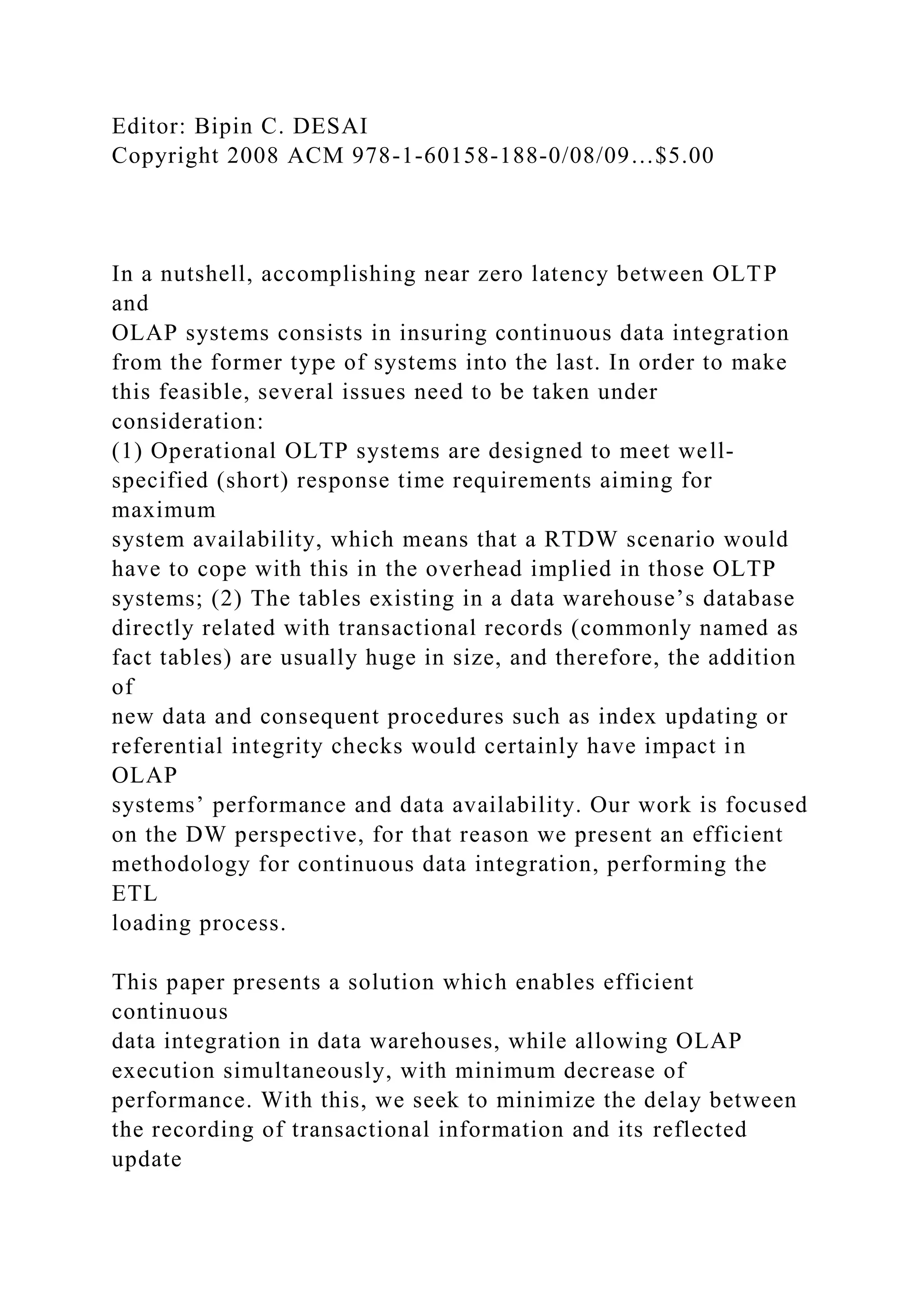
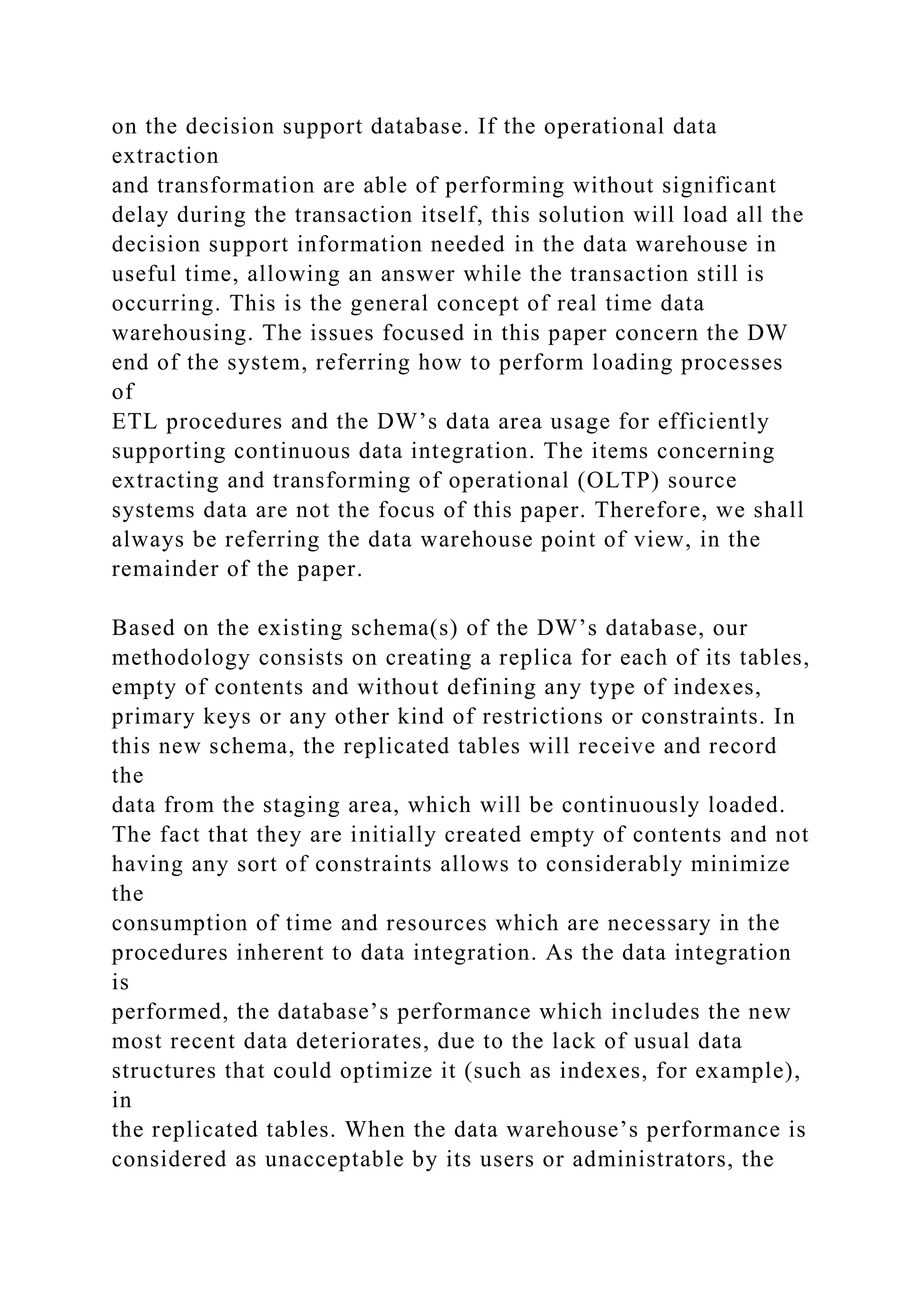
![existing data within the replicated tables should serve for
updating
the original schema. After performing this update, the replicated
tables are to be recreated empty of contents, regaining
maximum
performance. We also demonstrate how to adapt OLAP queries
in
the new schema, to take advantage of the most recent data
which
is integrated in real time.
The experiments which are presented were performed using a
standard benchmark for decision support systems, benchmark
TPC-H, from the Transaction Processing Council [22]. Several
configurations were tested, varying items such as the database’s
physical size, the number of simultaneous users executing
OLAP
queries, the amount of available RAM memory and the time
rates
between transactions.
The remainder of this paper is organized as follows. In section
2,
we refer the requirements for real-time data warehousing.
Section
3 presents background and related work in real-time data
warehousing. Section 4 explains our methodology, and in
section
5 we present the experimental evaluation of our methods and
demonstrate its functionality. The final section contains
concluding remarks and future work
2. REQUIREMENTS FOR REAL-TIME
DATA WAREHSOUSING](https://image.slidesharecdn.com/real-timedatawarehouseloadingmethodologyricardojorges-221031045647-57ea5f98/75/Real-Time-Data-Warehouse-Loading-Methodology-Ricardo-Jorge-S-docx-7-2048.jpg)
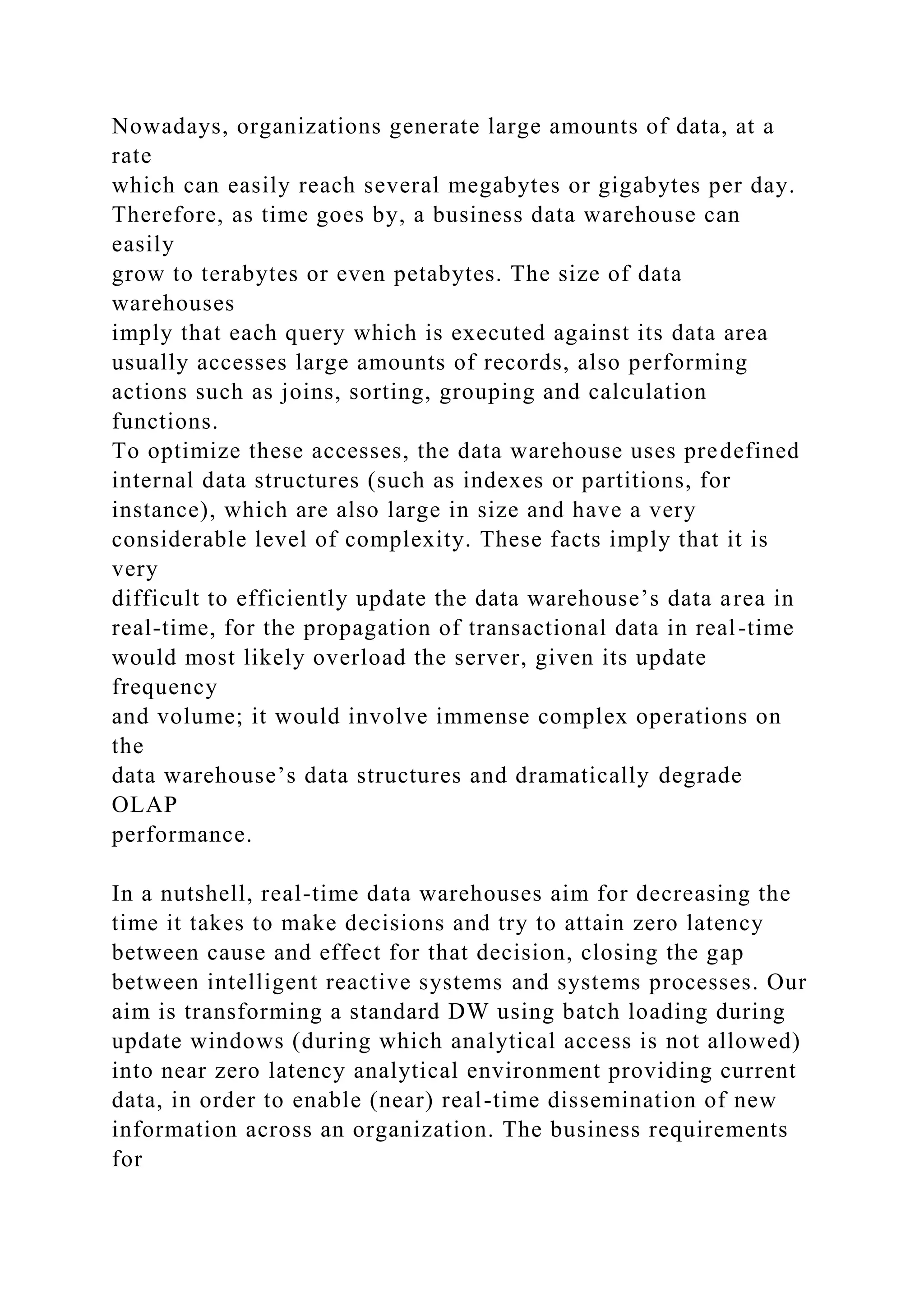
![this kind of analytical environment introduce a set of service
level
agreements that go beyond what is typical in a traditional DW.
The major issue is how to enable continuous data integration
and
assuring that it minimizes negative impact in several main
features of the system, such as availability and response time of
both OLTP and OLAP systems.
An in-depth discussion of these features from the analytical
point
of view (to enable timely consistent analysis) is given in [6].
Combining highly available systems with active decision
engines
allows near real-time information dissemination for data
warehouses. Cumulatively, this is the basis for zero latency
analytical environments [6]. The real-time data warehouse
provides access to an accurate, integrated, consolidated view of
the organization’s information and helps to deliver near real-
time
information to its users. This requires efficient ETL techniques
enabling continuous data integration, the focus of this paper.
By adopting real-time data warehousing, it becomes necessary
to
cope with at least two radical data state changes. First, it is
necessary to perform continuous data update actions, due to the
continuous data integration, which should mostly concern row
insertions. Second, these update actions must be performed in
parallel with the execution of OLAP, which – due to its new
real-
time nature – will probably be solicited more often. Therefore,
the
main contributions of this paper are threefold:](https://image.slidesharecdn.com/real-timedatawarehouseloadingmethodologyricardojorges-221031045647-57ea5f98/75/Real-Time-Data-Warehouse-Loading-Methodology-Ricardo-Jorge-S-docx-9-2048.jpg)
![• Maximizing the freshness of data by efficiently and
rapidly integrating most recent OLTP data into the data
warehouse;
• Minimizing OLAP response time while simultaneously
performing continuous data integration;
• Maximizing the data warehouse’s availability by reducing
its update time window, in which users and OLAP
applications are off-line.
3. RELATED WORK
So far, research has mostly dealt with the problem of
maintaining
the warehouse in its traditional periodical update setup [14, 27].
Related literature presents tools and algorithms to populate the
warehouse in an off-line fashion. In a different line of research,
data streams [1, 2, 15, 20] could possibly appear as a potential
solution. However, research in data streams has focused on
topics
concerning the front-end, such as on-the-fly computation of
queries without a systematic treatment of the issues raised at the
back-end of a data warehouse [10]. Much of the recent work
dedicated to RTDW is also focused on conceptual ETL
modelling
[4, 5, 19, 23], lacking the presentation of concrete specific
extraction, transformation and loading algorithms along with
their
consequent OLTP and OLAP performance issues.
Temporal data warehouses address the issue of supporting
temporal information efficiently in data warehousing systems
[25]. In [27], the authors present efficient techniques (e.g.
temporal view self-maintenance) for maintaining data
warehouses](https://image.slidesharecdn.com/real-timedatawarehouseloadingmethodologyricardojorges-221031045647-57ea5f98/75/Real-Time-Data-Warehouse-Loading-Methodology-Ricardo-Jorge-S-docx-10-2048.jpg)
![without disturbing source operations. A related challenge is
supporting large-scale temporal aggregation operations in data
warehouses [26]. In [4], the authors describe an approach which
clearly separates the DW refreshment process from its
traditional
handling as a view maintenance or bulk loading process. They
provide a conceptual model of the process, which is treated as a
composite workflow, but they do not describe how to efficiently
propagate the date. Theodoratus et al. discuss in [21] data
currency quality factors in data warehouses and propose a DW
design that considers these factors.
An important issue for near real-time data integration is the
accommodation of delays, which has been investigated for
(business) transactions in temporal active databases [18]. The
conclusion is that temporal faithfulness for transactions has to
be
provided, which preserves the serialization order of a set of
business transactions. Although possibly lagging behind real-
time,
a system that behaves in a temporally faithful manner
guarantees
the expected serialization order.
In [23], the authors describe the ARKTOS ETL tool, capable of
modeling and executing practical ETL scenarios by providing
explicit primitives for capturing common tasks (such as data
cleaning, scheduling and data transformations) using a
declarative
language. ARKTOS offers graphical and declarative features for
defining DW transformations and tries to optimize the execution
of complex sequences of transformation and cleansing tasks.
In [13] is described a zero-delay DW with Gong, which assists
in](https://image.slidesharecdn.com/real-timedatawarehouseloadingmethodologyricardojorges-221031045647-57ea5f98/75/Real-Time-Data-Warehouse-Loading-Methodology-Ricardo-Jorge-S-docx-11-2048.jpg)
![providing confidence in the data available to every branch of
the
organization. Gong is a Tecco product [3] that offers uni or bi-
directional replication of data between homogeneous and/or
heterogeneous distributed databases. Gong’s database
replication
enables zero-delay business in order to assist in the daily
running
and decision making of the organization.
But not all transactional informations need to be immediately
dealt with in real-time decision making requirements. We can
define which groups of data is more important to include
rapidly
in the data warehouse and other groups of data which can be
updated in latter time. Recently, in [9], the authors present an
interesting architecture on how to define the types of update and
time priorities (immediate, at specific time intervals or only on
data warehouse offline updates) and respective synchronization
for each group of transactional data items.
Our methodology overcomes some of the mentioned drawbacks
and is presented in the next section.
4. CONTINUOUS DATA WAREHOUSE
LOADING METHODOLOGY
From the DW side, updating huge tables and related structures
(such as indexes, materialized views and other integrated
components) makes executing OLAP query workloads
simultaneously with continuous data integration a very difficult
task. Our methodology minimizes the processing time and
workload required for these update processes. It also facilitates
the DW off-line update (see section 4.4), because the data
already
lies within the data area and all OLTP data extraction and/or
transformation routines have been executed during the](https://image.slidesharecdn.com/real-timedatawarehouseloadingmethodologyricardojorges-221031045647-57ea5f98/75/Real-Time-Data-Warehouse-Loading-Methodology-Ricardo-Jorge-S-docx-12-2048.jpg)
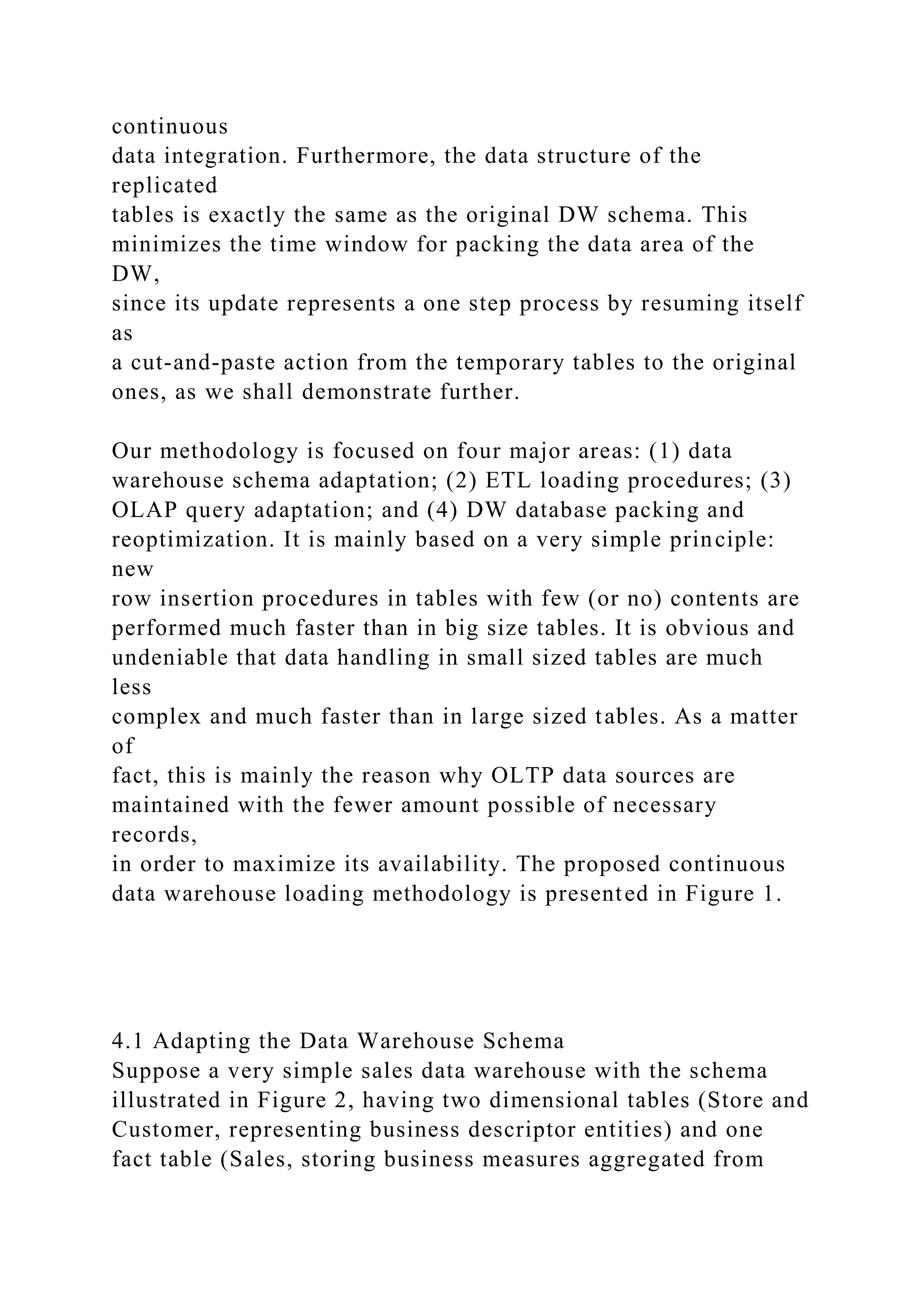
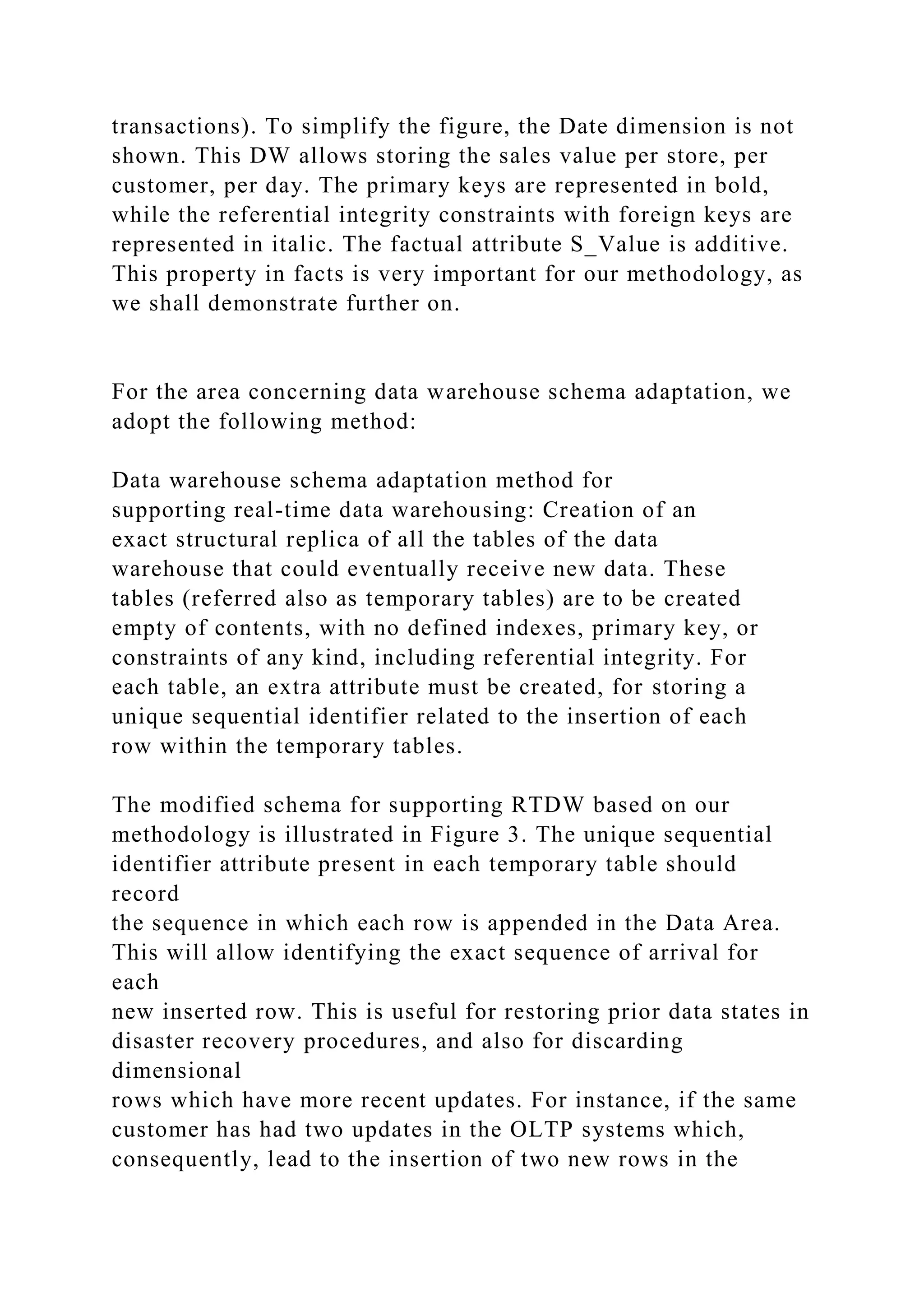
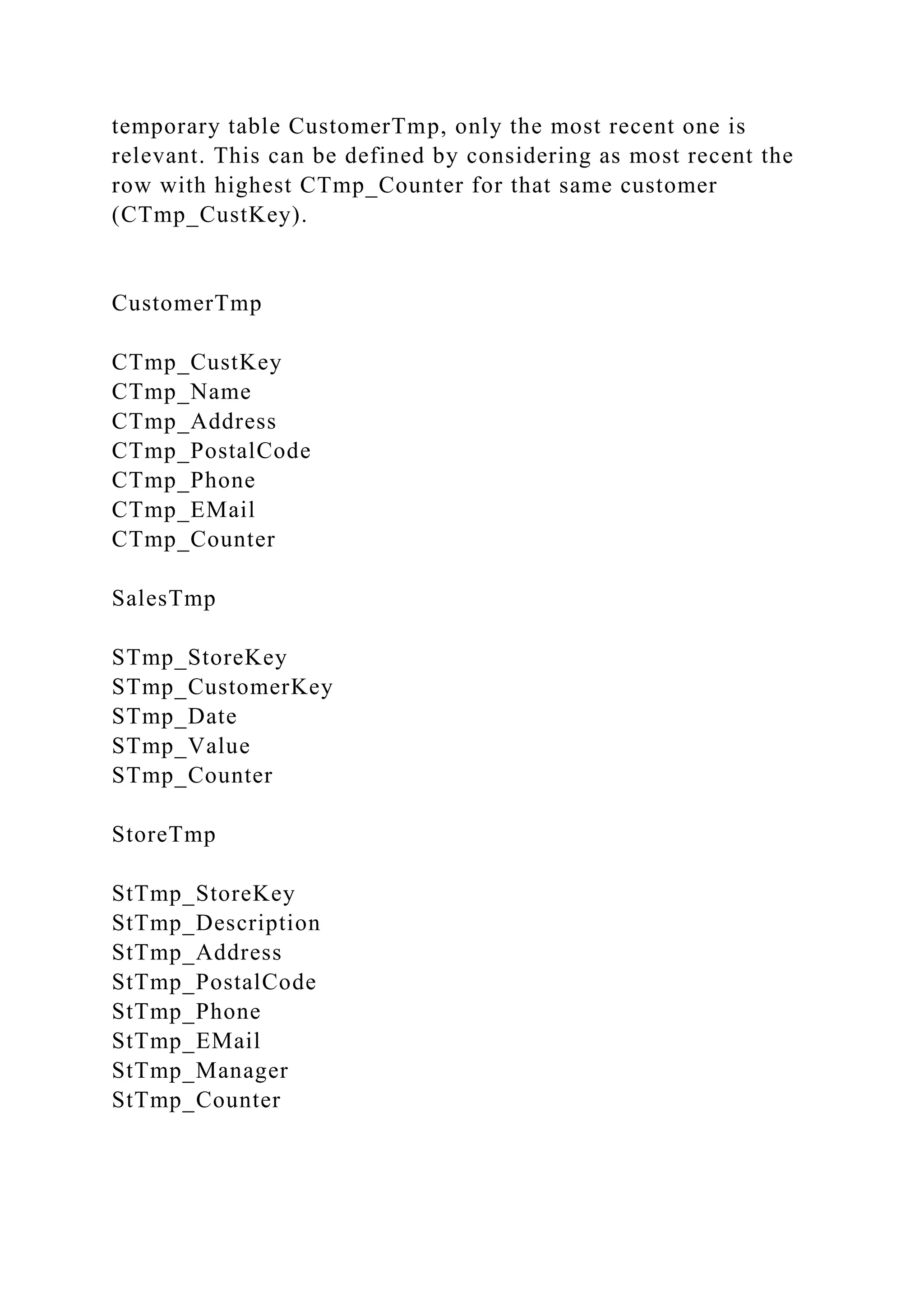
![The authors of the ARKTOS tool [23] refer that their own
experience, as well as the most recent literature, suggests that
the
main problems of ETL tools do not consist only in performance
problems (as normally would be expected), but also in aspects
such as complexity, practibility and price. By performing only
record insertion procedures inherent to continuous data
integration using empty or small sized tables without any kind
of
constraint or attached physical file related to it, we guarantee
the
simplest and fastest logical and physical support for achieving
our
goals [12].
The fact that the only significant change in the logical and
physical structure of the data warehouse’s schema is the simple
adaptation shown in Figure 3, allows that the implementation of
the necessary ETL procedures can be made in a manner to
maximize its operationability. Data loading may be done by
simple standard SQL instructions or DBMS batch loading
software such as SQL*Loader [16], with a minimum of
complexity. There is no need for developing complex routines
for
updating the data area, in which the needed data for is easily
accessible, independently from the used ETL tools.
4.2 ETL Loading Procedures
To refresh the data warehouse, once the ETL application has
extracted and transformed the OLTP data into the correct format
for loading the data area of the DW, it shall proceed
immediately
in inserting that record as a new row in the correspondent
temporary table, filling the unique sequential identifier attribute
with the autoincremented sequential number. This number
should](https://image.slidesharecdn.com/real-timedatawarehouseloadingmethodologyricardojorges-221031045647-57ea5f98/75/Real-Time-Data-Warehouse-Loading-Methodology-Ricardo-Jorge-S-docx-16-2048.jpg)
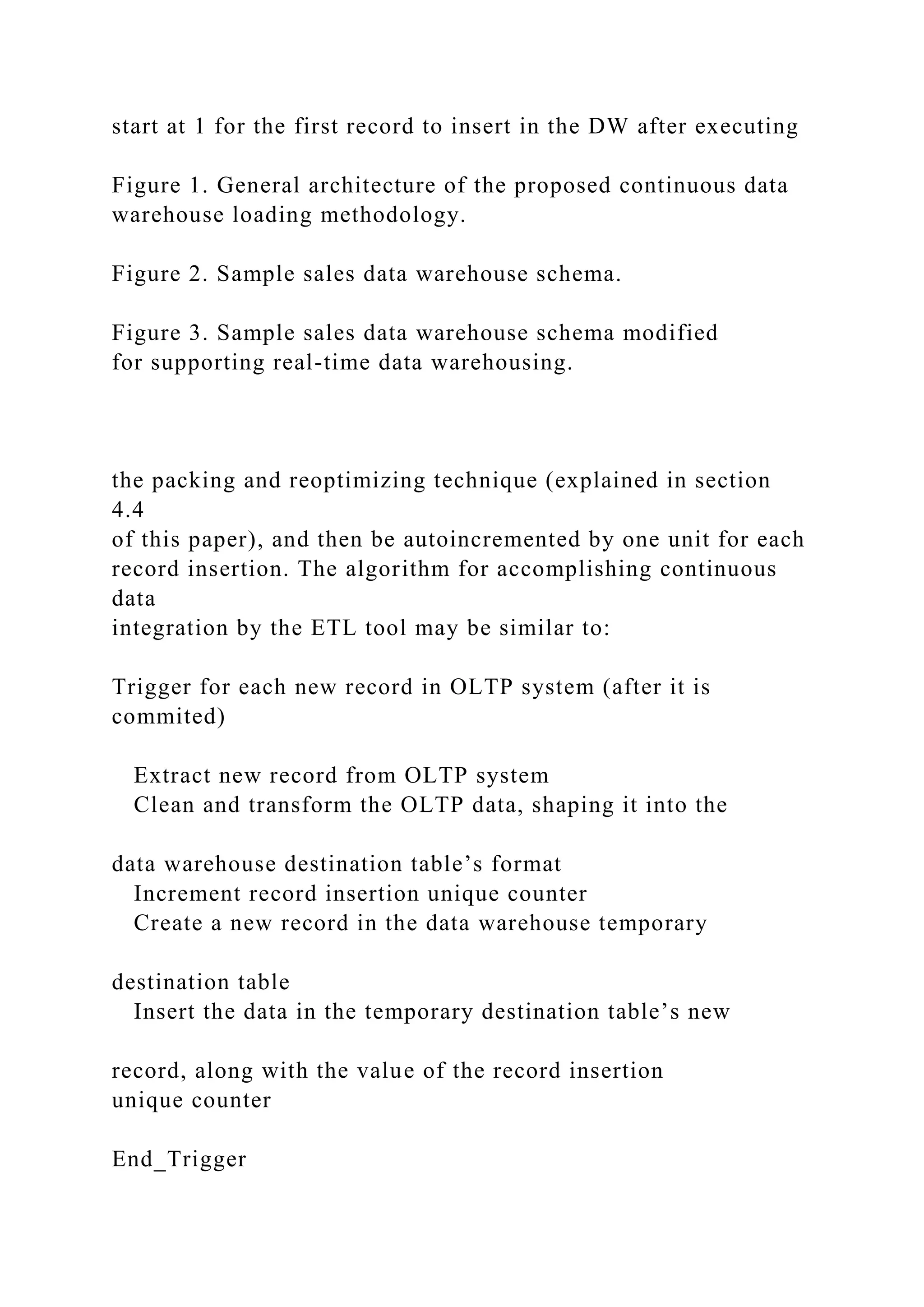
![Following, we demonstrate a practical example for explaining
situations regarding updating the data warehouse shown in
Figure
3. Figure 4 presents the insertion of a row in the data warehouse
temporary fact table for the recording of a sales transaction of
value 100 which took place at 2008-05-02 in store with
St_StoreKey = 1 related to customer with C_CustKey = 10,
identified by STmp_Counter = 1001. Meanwhile, other
transactions occurred, and the organization’s OLTP system
recorded that instead of a value of 100 for the mentioned
transaction, it should be 1000. The rows in the temporary fact
table with STmp_Counter = 1011 and STmp_Counter =
1012 reflect this modification of values. The first eliminates the
value of the initial transactional row and the second has the new
real value, due to the additivity of the STmp_Value attribute.
The definition of which attributes are additive and which are
not
should be the responsibility of the Database Administrator.
According to [11], the most useful facts in a data warehouse are
numeric and additive.
The method for data loading uses the most simple method for
writing data: appending new records. Any other type of writing
method needs the execution of more time consuming and
complex
tasks.
STmp_StoreKey STmp_CustomerKey STmp_Date STmp_Value
STmp_Counter
1 10 2008-05-02 100 1001](https://image.slidesharecdn.com/real-timedatawarehouseloadingmethodologyricardojorges-221031045647-57ea5f98/75/Real-Time-Data-Warehouse-Loading-Methodology-Ricardo-Jorge-S-docx-18-2048.jpg)

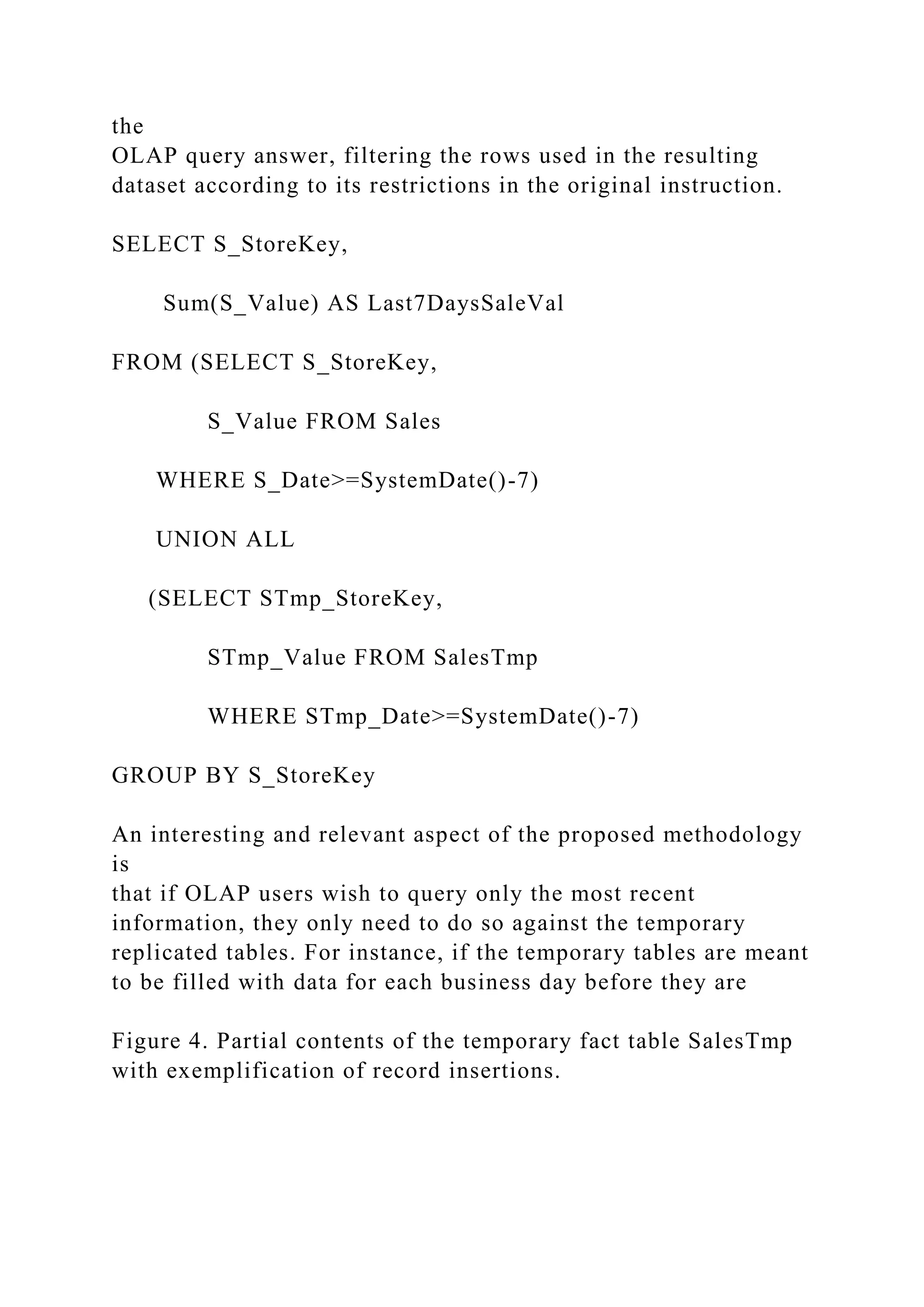
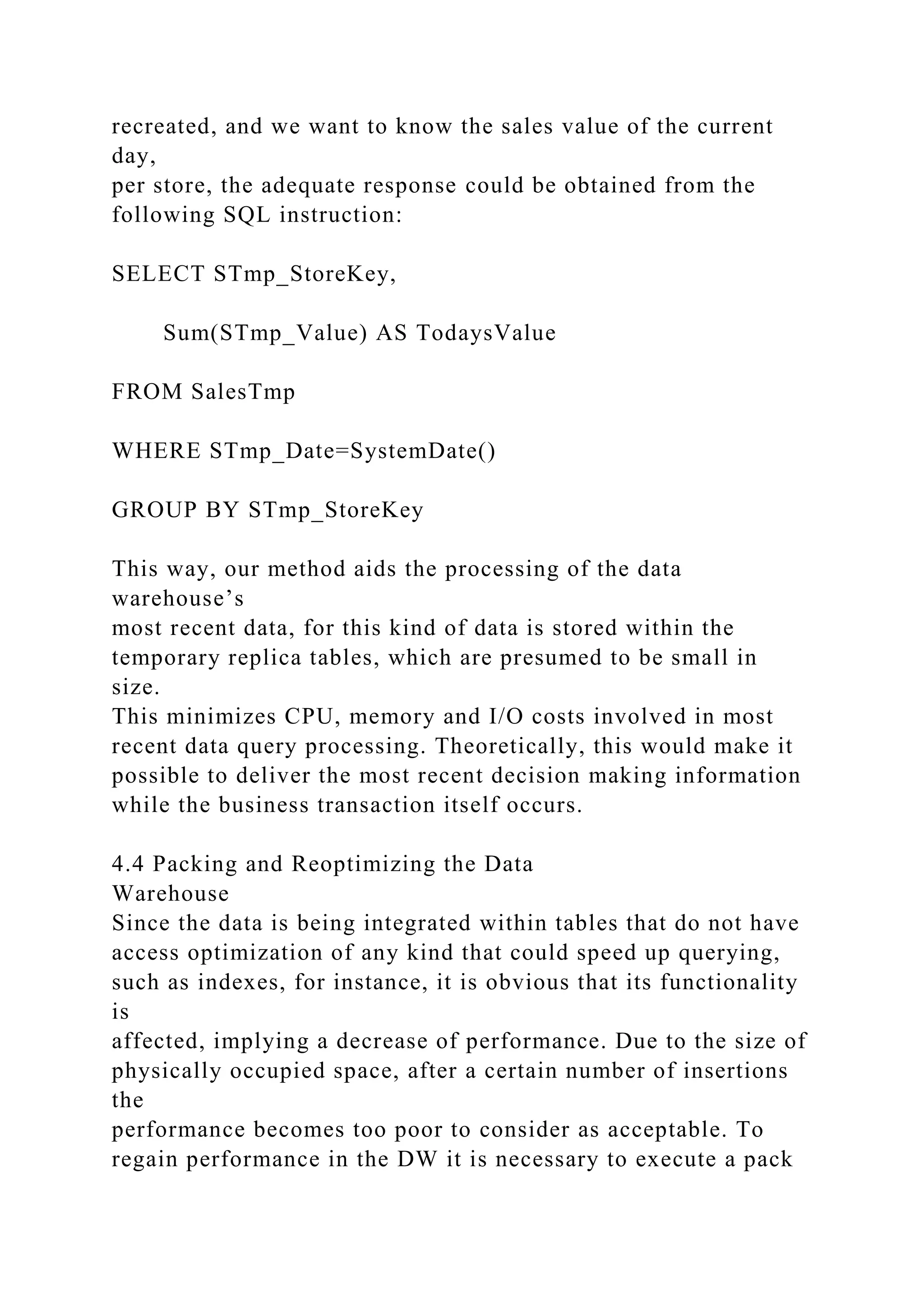
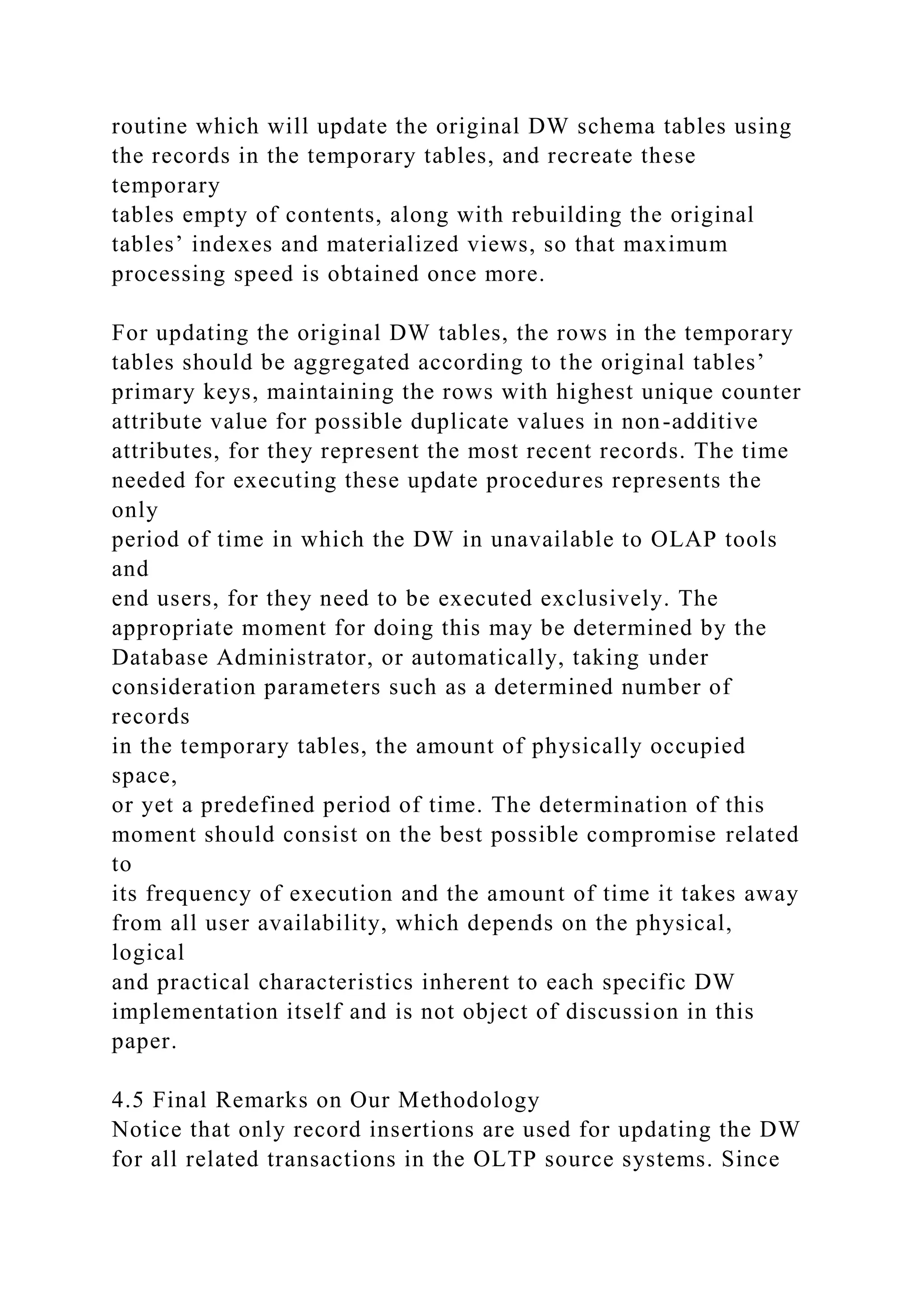
![this
type of procedure does not require any record locking in the
tables (except for the appended record itself) nor search
operations for previously stored data before writing data (like in
update or delete instructions), the time necessary to accomplish
this is minimal. The issue of record locking is strongly enforced
by the fact that the referred tables do not have any indexes or
primary keys, implying absolutely no record locking, except for
the appended record itself. Furthermore, since they do not have
constraints of any sort, including referential integrity and
primary
keys, there is no need to execute time consuming tasks such as
index updating or referential integrity cross checks. Kimball
refers in [12] that many ETL tools use a UPDATE ELSE
INSERT
function in loading data, considering this as a performance
killer.
With our method, any appending, updating or eliminating data
tasks on OLTP systems reflect themselves as only new record
insertions in the data warehouse, which allows minimizing row,
block and table locks and other concurrent data access
problems.
Physical database tablespace fragmentation is also avoided,
once
there is now deletion of data, only sequential increments. This
allows us to state that the data update time window for our
methods is minimal for the insertion of new data, maximizing
the
availability of that data, and consequently contributing to
effectively increase the data warehouses’ global availability and
minimize any negative impact in its performance.
As mentioned earlier, the extracted data usually needs to be
corrected and transformed before updating the data warehouse’s
data area. Since we pretend to obtain this data near real-time,](https://image.slidesharecdn.com/real-timedatawarehouseloadingmethodologyricardojorges-221031045647-57ea5f98/75/Real-Time-Data-Warehouse-Loading-Methodology-Ricardo-Jorge-S-docx-23-2048.jpg)
![the
time gap between recording OLTP transactions and their
extraction by ETL processes is minimal, occurring nearly at the
same time, which somewhat reduces error probability. We can
also assume that the amount of intermediate “information
buckets” which the data passes through in the ETL Area is also
minimal, for temporary storage is almost not needed.
Furthermore, instead of extracting a considerable amount of
OLTP data, which is what happens in the “traditional” bulk
loading data warehousing, the volume of information extracted
and transformed in real-time is extremely reduced (representing
commonly few dozen bytes), since it consists of only one
transaction per execution cycle. All this allows assuming that
the
extraction and transformation phase will be cleaner and more
time
efficient.
As a limitation to our methodology, data warehouse contexts in
which additive attributes are difficult or even not possible to
define for their fact tables may invalidate its practice.
5. EXPERIMENTAL EVALUATION
Recurring to TPC-H decision support benchmark (TPC-H) we
tested our methodology, creating 5GB, 10GB and 20GB sized
DWs for continuous data integration at several time rates, in
ORACLE 10g DBMS [16]. We used an Intel Celeron 2.8GHz
with variations of 512MB, 1GB and 2GB of SDRAM and a
7200rpm 160GB hard disk. The modified TPC-H schema
according to our methodology can be seen in Figure 5. Tables
Region and Nation are not included as temporary tables
because they are fixed-size tables in the TPC-H benchmark, and
therefore do not receive new data. For the query workloads we
selected TPC-H queries 1, 8, 12 and 20 (TPC-H), executed in
random order for each simultaneous user in the tests, for up to 8
hours of testing for each scenario.](https://image.slidesharecdn.com/real-timedatawarehouseloadingmethodologyricardojorges-221031045647-57ea5f98/75/Real-Time-Data-Warehouse-Loading-Methodology-Ricardo-Jorge-S-docx-24-2048.jpg)

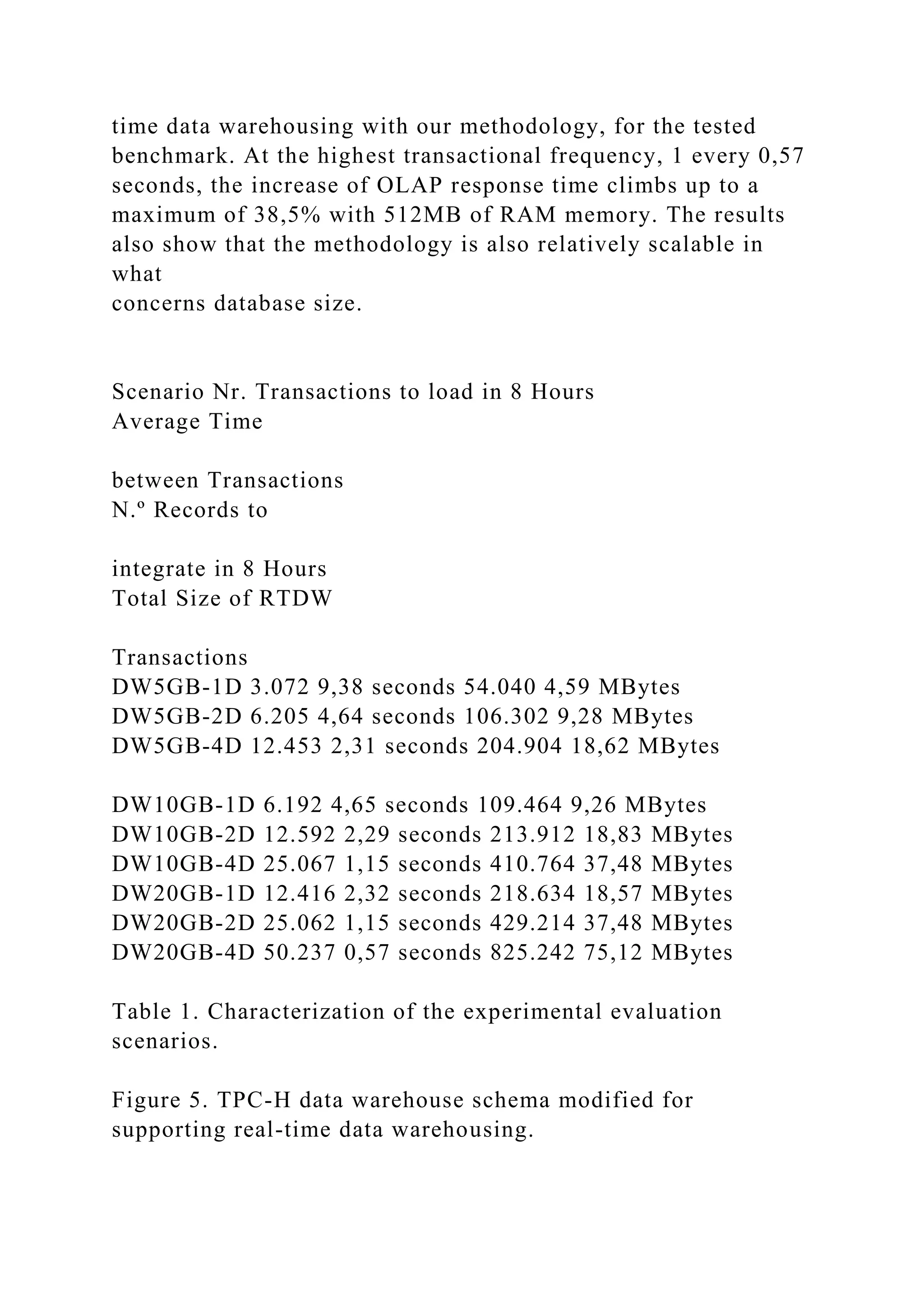
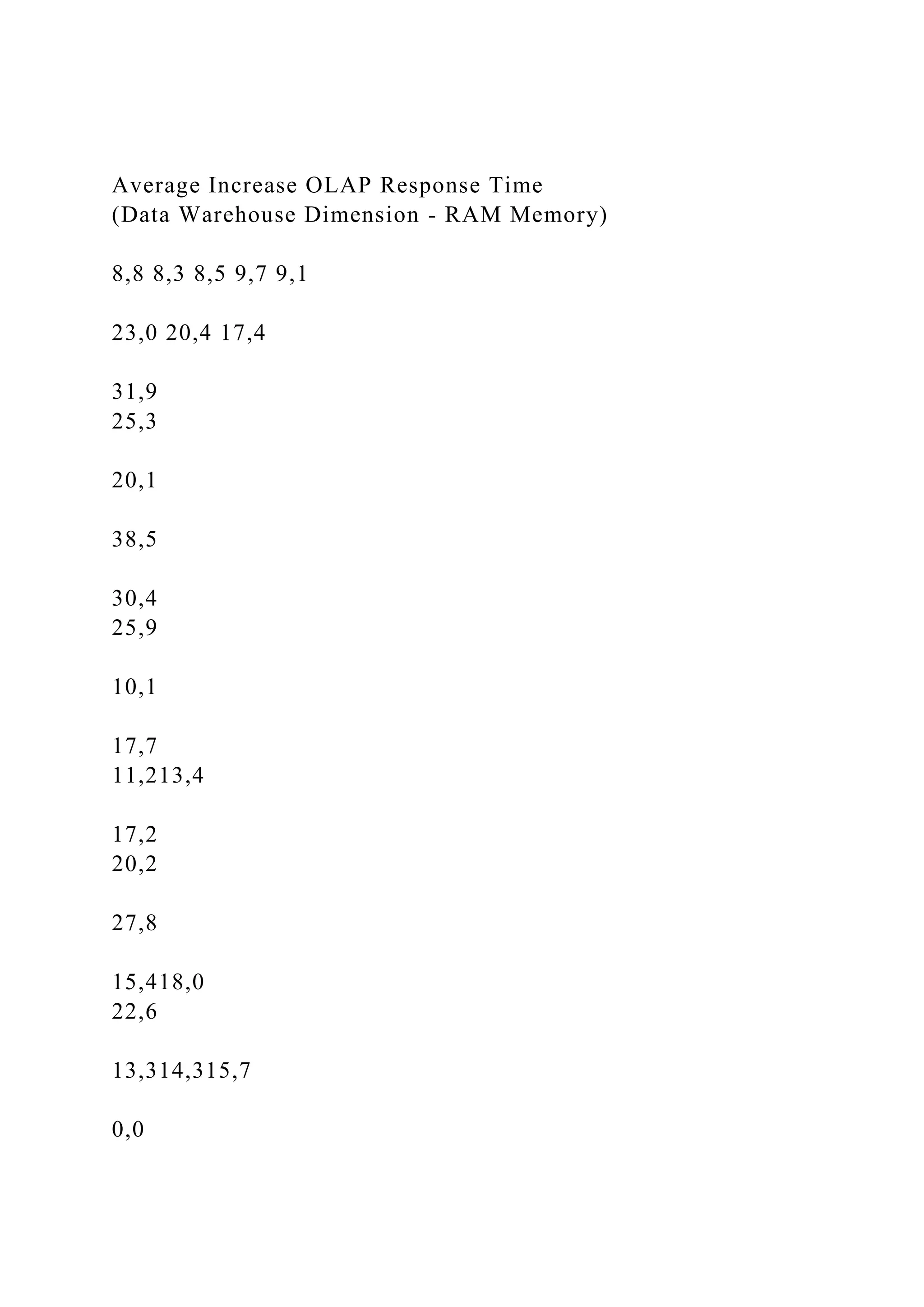
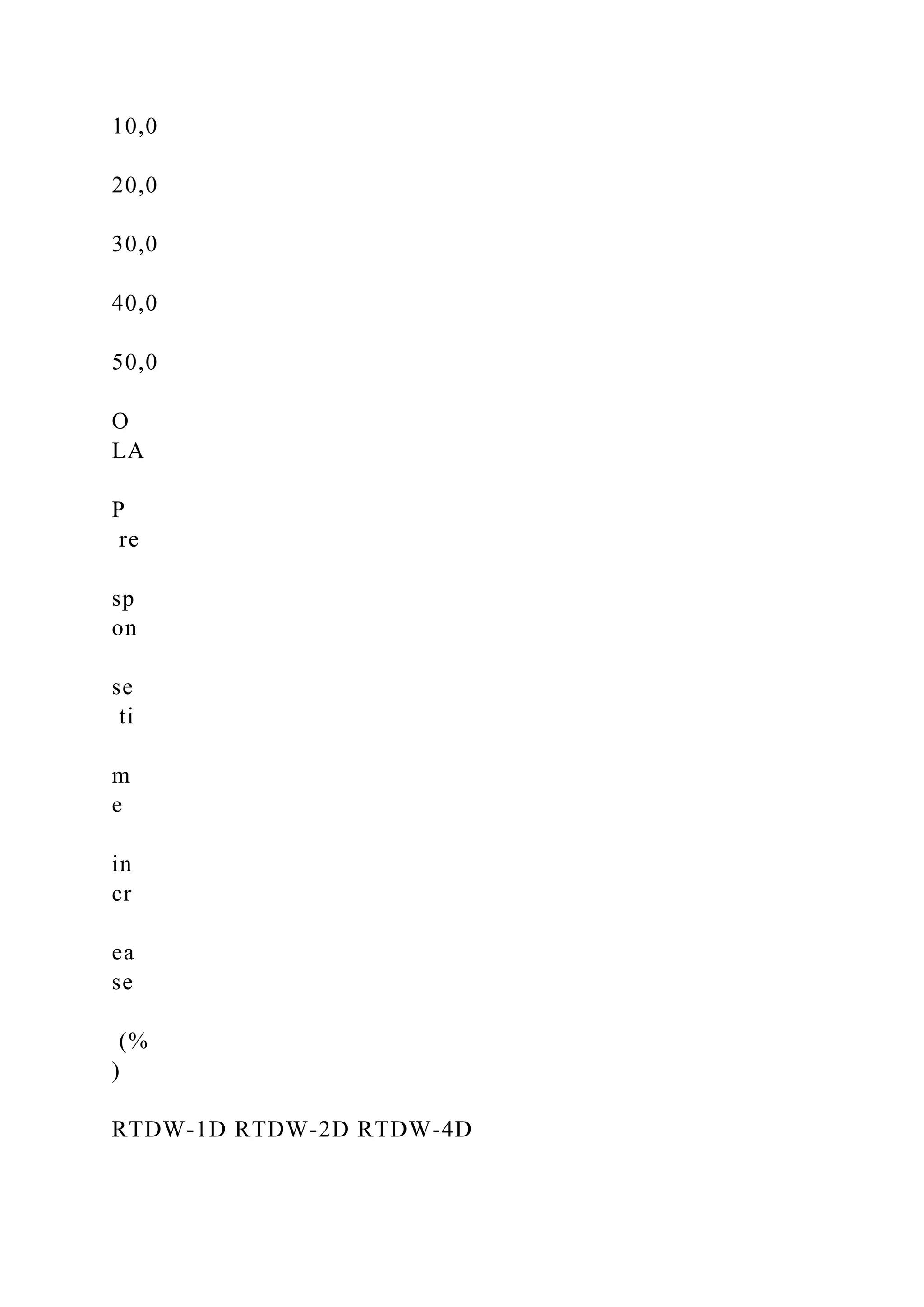
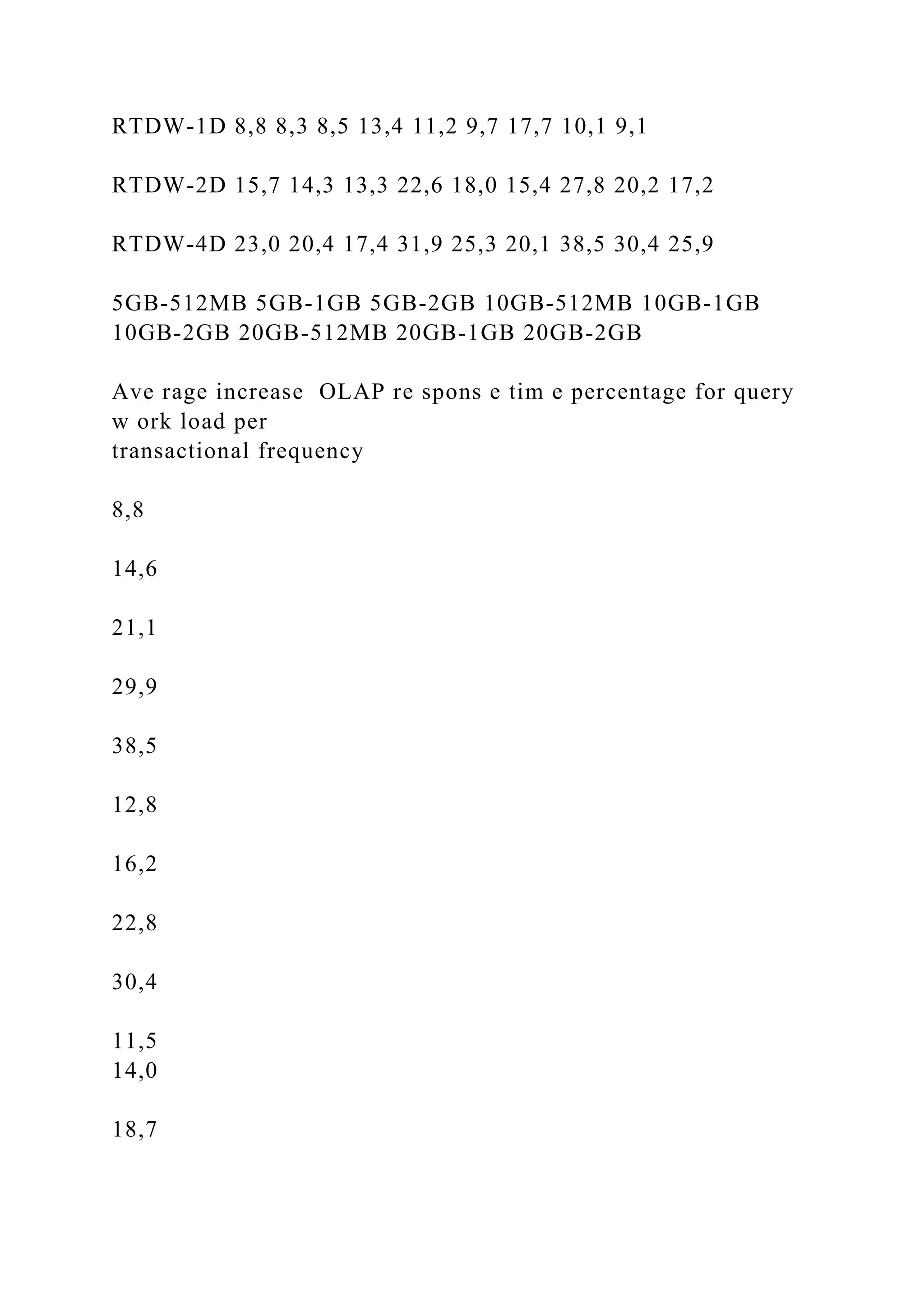
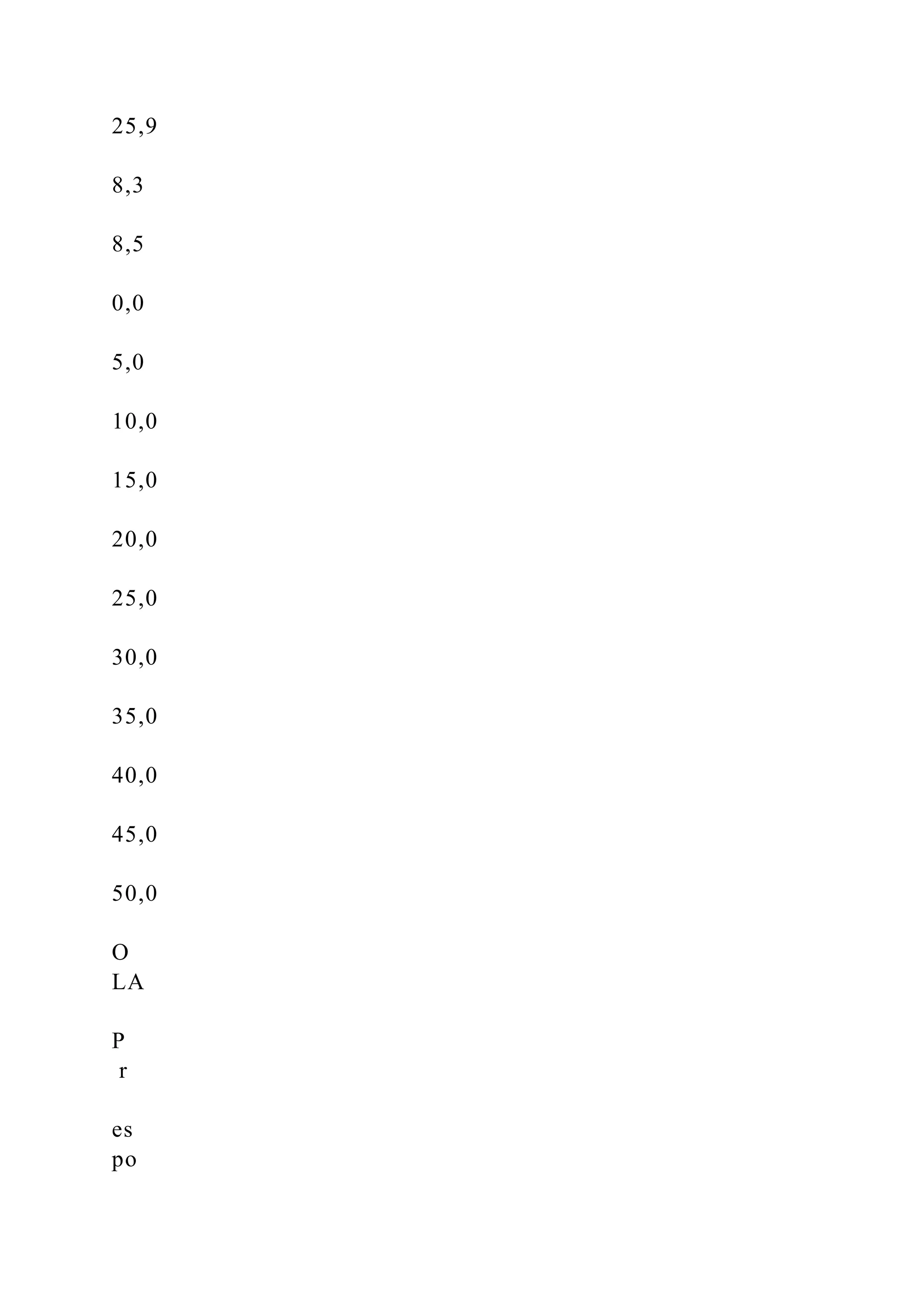
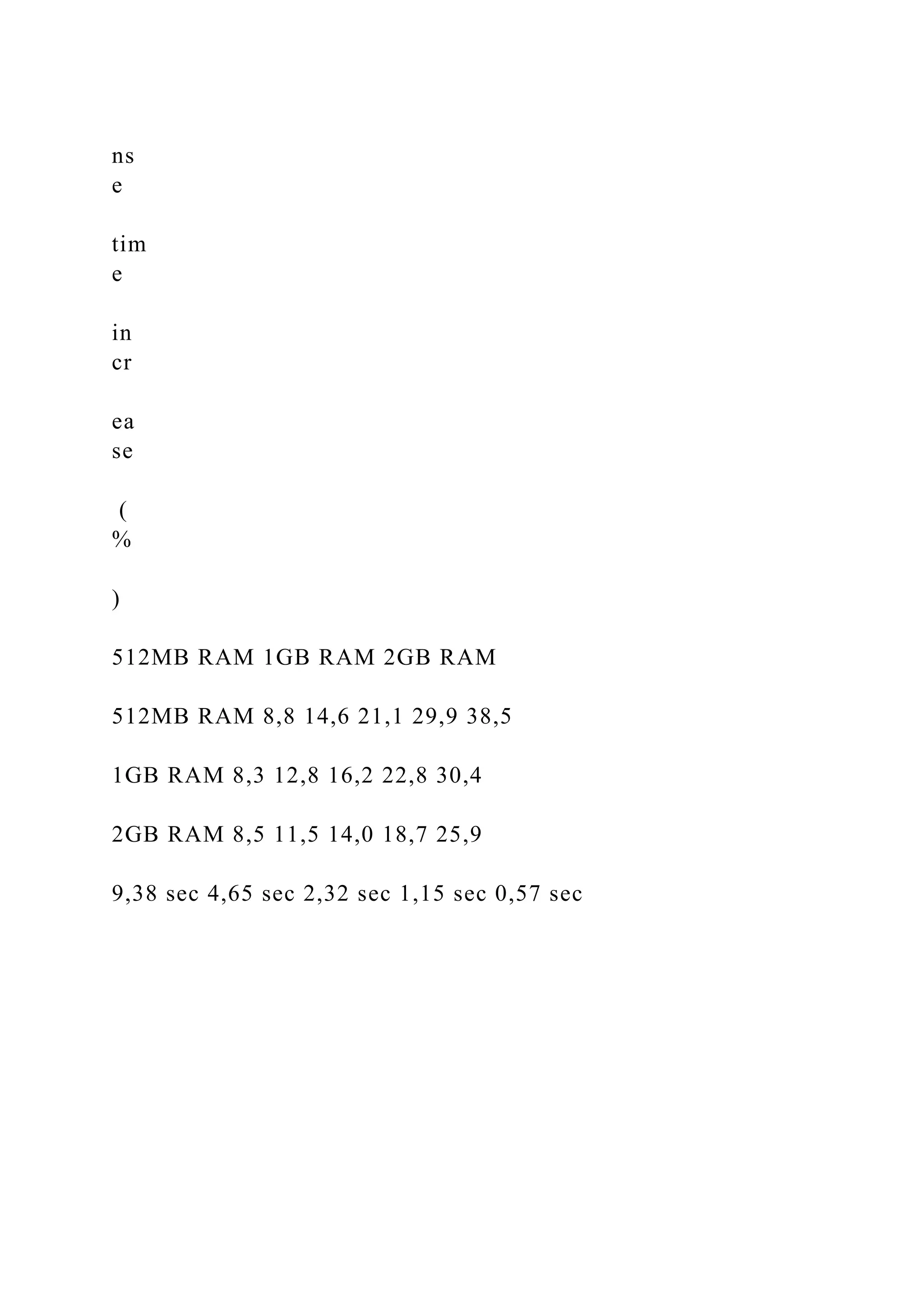
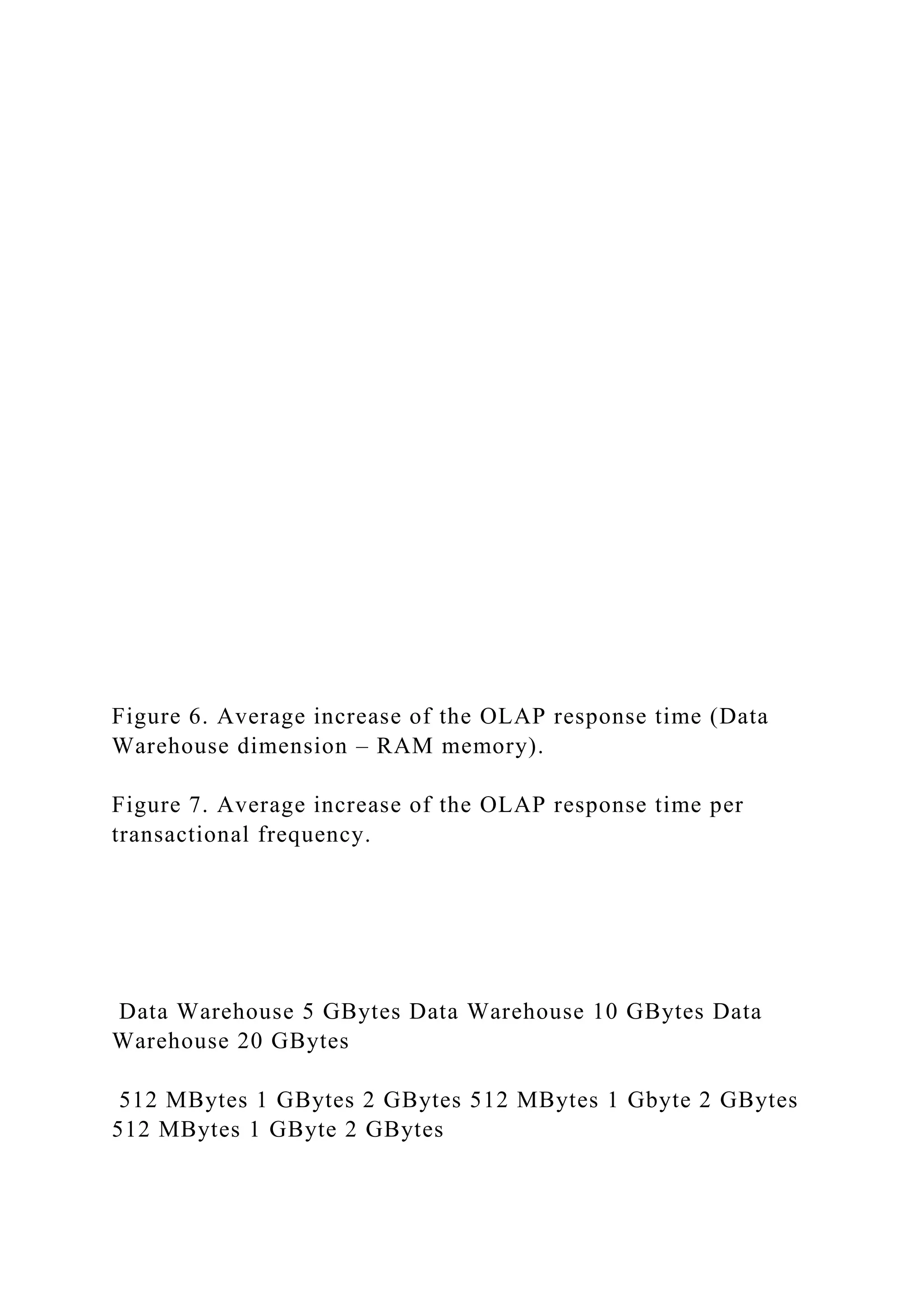
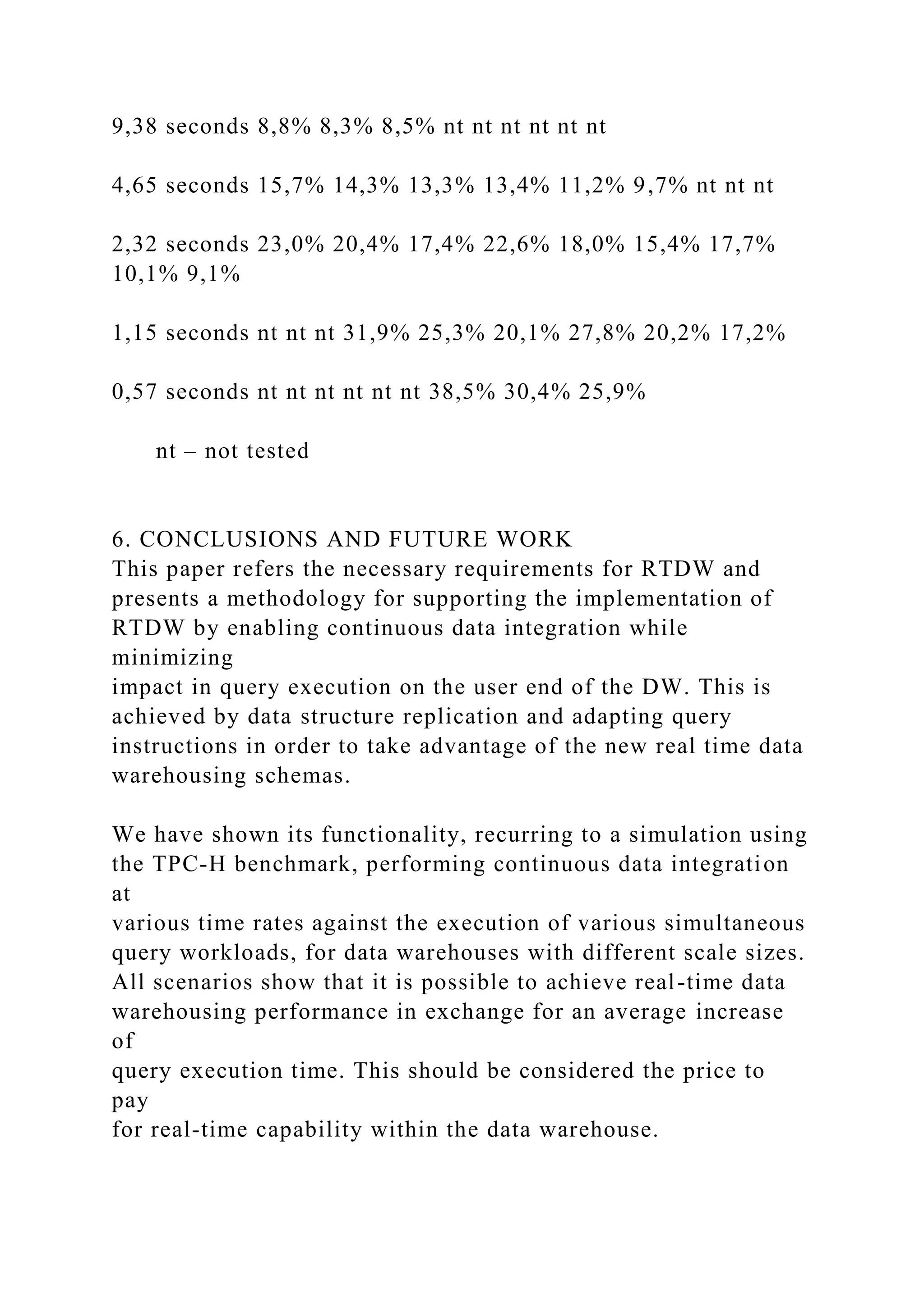
![As future work we intend to develop an ETL tool which will
integrate this methodology with extraction and transformation
routines for the OLTP systems. There is also room for
optimizing
the query instructions used for our methods.
7. REFERENCES
[1] D. J. Abadi, D. Carney, et al., 2003. “Aurora: A New Model
and Architecture for Data Stream Management”, The VLDB
Journal, 12(2), pp. 120-139.
[2] S. Babu, and J. Widom, 2001. “Continuous Queries Over
Data Streams”, SIGMOD Record 30(3), pp. 109-120.
[3] T. Binder, 2003. Gong User Manual, Tecco Software
Entwicklung AG.
[4] M. Bouzeghoub, F. Fabret, and M. Matulovic, 1999.
“Modeling Data Warehouse Refreshment Process as a
Workflow Application”, Intern. Workshop on Design and
Management of Data Warehouses (DMDW).
[5] R. M. Bruckner, B. List, and J. Schiefer, 2002. “Striving
Towards Near Real-Time Data Integration for Data
Warehouses”, International Conference on Data Warehousing
and Knowledge Discovery (DAWAK).
[6] R. M. Bruckner, and A. M. Tjoa, 2002. “Capturing Delays
and Valid Times in Data Warehouses – Towards Timely
Consistent Analyses”. Journal of Intelligent Information
Systems (JIIS), 19:2, pp. 169-190.
[7] S. Chaudhuri, and U. Dayal, 1997. “An Overview of Data
Warehousing and OLAP Technology”, SIGMOD Record,](https://image.slidesharecdn.com/real-timedatawarehouseloadingmethodologyricardojorges-221031045647-57ea5f98/75/Real-Time-Data-Warehouse-Loading-Methodology-Ricardo-Jorge-S-docx-34-2048.jpg)
![Volume 26, Number 1, pp. 65-74.
[8] W. H. Inmon, R. H. Terdeman, J. Norris-Montanari, and D.
Meers, 2001. Data Warehousing for E-Business, J. Wiley &
Sons.
[9] I. C. Italiano, and J. E. Ferreira, 2006. “Synchronization
Options for Data Warehouse Designs”, IEEE Computer
Magazine.
[10] A. Karakasidis, P. Vassiliadis, and E. Pitoura, 2005. “ETL
Queues for Active Data Warehousing”, IQIS’05.
[11] R. Kimball, L. Reeves, M. Ross, and W. Thornthwaite,
1998.
The Data Warehouse Lifecycle Toolkit – Expert Methods for
Designing, Developing and Deploying Data Warehouses,
Wiley Computer Publishing.
[12] R. Kimball, and J. Caserta, 2004. The Data Warehouse ETL
Toolkit, Wiley Computer Publishing.
[13] E. Kuhn, 2003. “The Zero-Delay Data Warehouse:
Mobilizing Heterogeneous Databases”, International
Conference on Very Large Data Bases (VLDB).
[14] W. Labio, J. Yang, Y. Cui, H. Garcia-Molina, and J.
Widom,
2000. “Performance Issues in Incremental Warehouse
Maintenance”, International Conference on Very Large Data
Bases (VLDB).
[15] D. Lomet, and J. Gehrke, 2003. Special Issue on Data
Stream Processing, IEEE Data Eng. Bulletin, 26(1).
[16] Oracle Corporation, 2005. www.oracle.com](https://image.slidesharecdn.com/real-timedatawarehouseloadingmethodologyricardojorges-221031045647-57ea5f98/75/Real-Time-Data-Warehouse-Loading-Methodology-Ricardo-Jorge-S-docx-35-2048.jpg)
![[17] T. B. Pedersen, 2004. “How is BI Used in Industry?”, Int.
Conf. on Data Warehousing and Knowledge Discovery
(DAWAK).
[18] J. F. Roddick, and M. Schrefl, 2000. “Towards an
Accommodation of Delay in Temporal Active Databases”,
11th ADC.
[19] A. Simitsis, P. Vassiliadis and T. Sellis, 2005. “Optimizing
ETL Processes in Data Warehouses”, Inte. Conference on
Data Engineering (ICDE).
Table 2. Characterization of the average increase of OLAP
response times for each experimental scenario.
[20] U. Srivastava, and J. Widom, 2004. “Flexible Time
Management in Data Stream Systems”, PODS.
[21] D. Theodoratus, and M. Bouzeghoub, 1999. “Data Currency
Quality Factors in Data Warehouse Design”, International
Workshop on the Design and Management of Data
Warehouses (DMDW).
[22] TPC-H decision support benchmark, Transaction
Processing
Council, www.tpc.com.
[23] P. Vassiliadis, Z. Vagena, S. Skiadopoulos, N.
Karayannidis,
and T. Sellis, 2001. “ARKTOS: Towards the Modelling,
Design, Control and Execution of ETL Processes”,
Information Systems, Vol. 26(8).](https://image.slidesharecdn.com/real-timedatawarehouseloadingmethodologyricardojorges-221031045647-57ea5f98/75/Real-Time-Data-Warehouse-Loading-Methodology-Ricardo-Jorge-S-docx-36-2048.jpg)
![[24] C. White, 2002. “Intelligent Business Strategies: Real-
Time
Data Warehousing Heats Up”, DM Preview,
www.dmreview.com/article_sub_cfm?articleId=5570.
[25] J. Yang, 2001. “Temporal Data Warehousing”, Ph.D.
Thesis, Dpt. Computer Science, Stanford University.
[26] J. Yang, and J. Widom, 2001. “Incremental Computation
and Maintenance of Temporal Aggregates”, 17th Intern.
Conference on Data Engineering (ICDE).
[27] J. Yang, and J. Widom, 2001. “Temporal View Self-
Maintenance”, 7th Int. Conf. Extending Database Technology
(EDBT).
[28] T. Zurek, and K. Kreplin, 2001. “SAP Business
Information
Warehouse – From Data Warehousing to an E-Business
Platform”, 17th International Conference on Data Engineering
(ICDE).
An Oracle White Paper
August 2012
Best Practices for Real-time Data Warehousing](https://image.slidesharecdn.com/real-timedatawarehouseloadingmethodologyricardojorges-221031045647-57ea5f98/75/Real-Time-Data-Warehouse-Loading-Methodology-Ricardo-Jorge-S-docx-37-2048.jpg)

